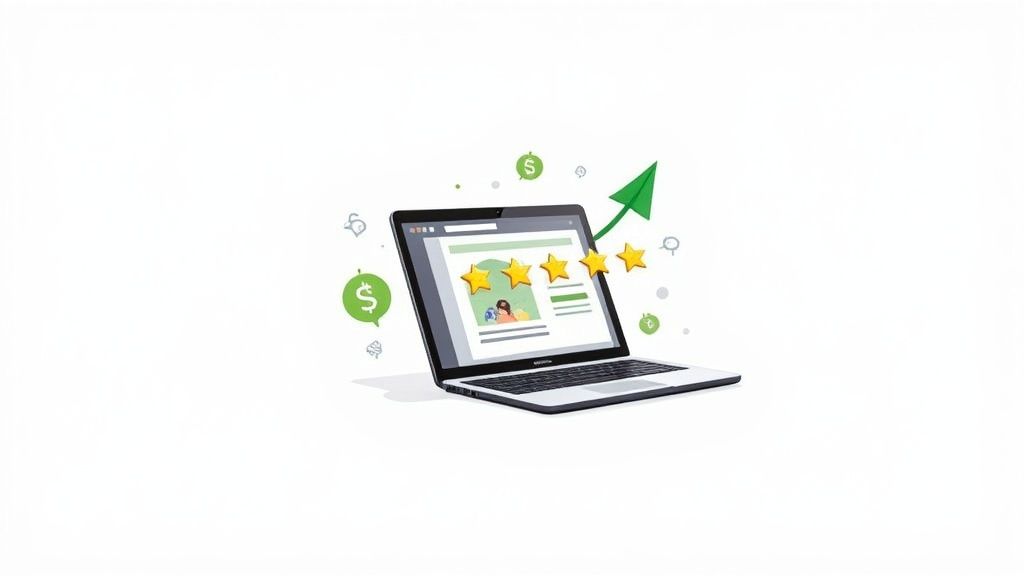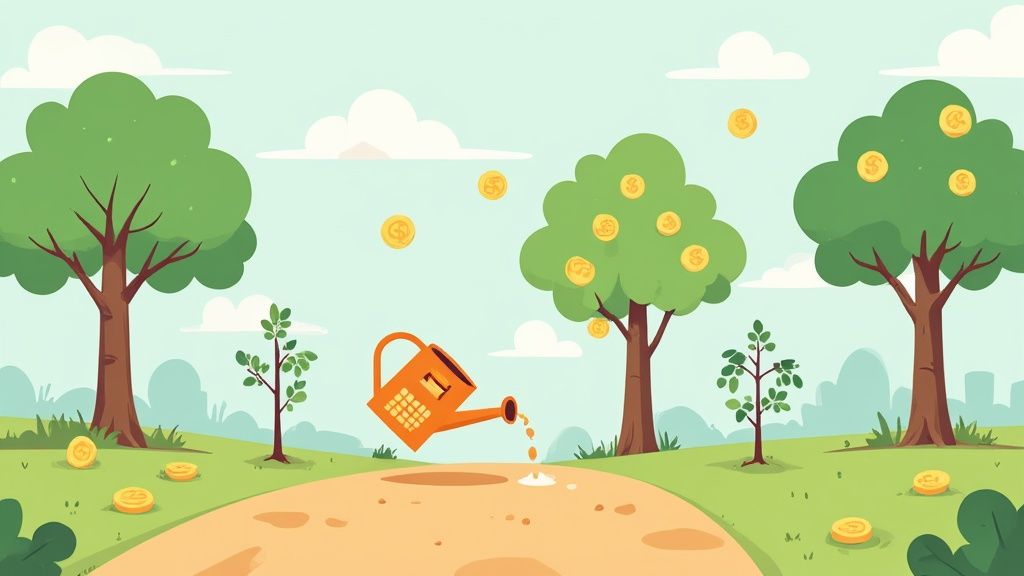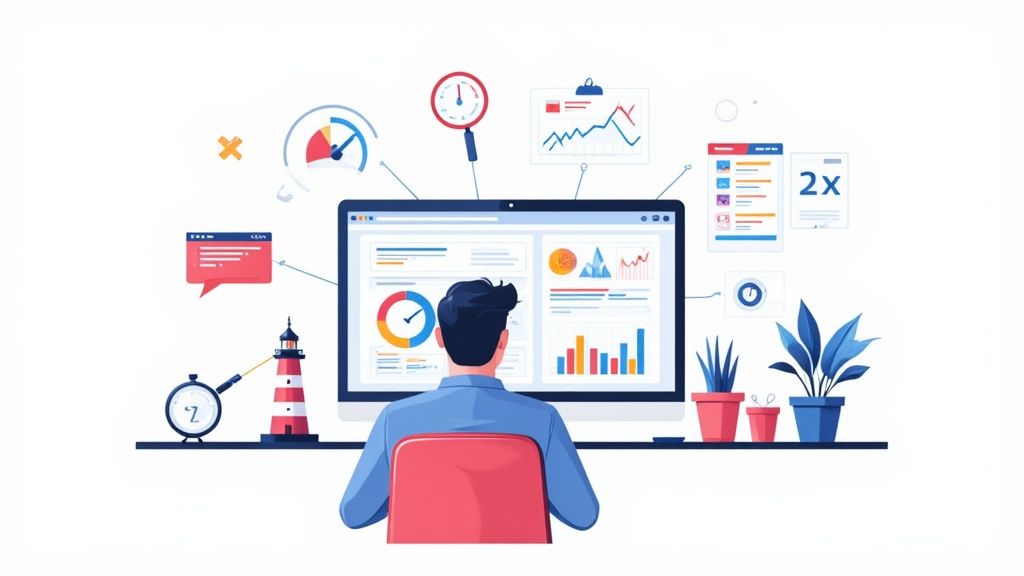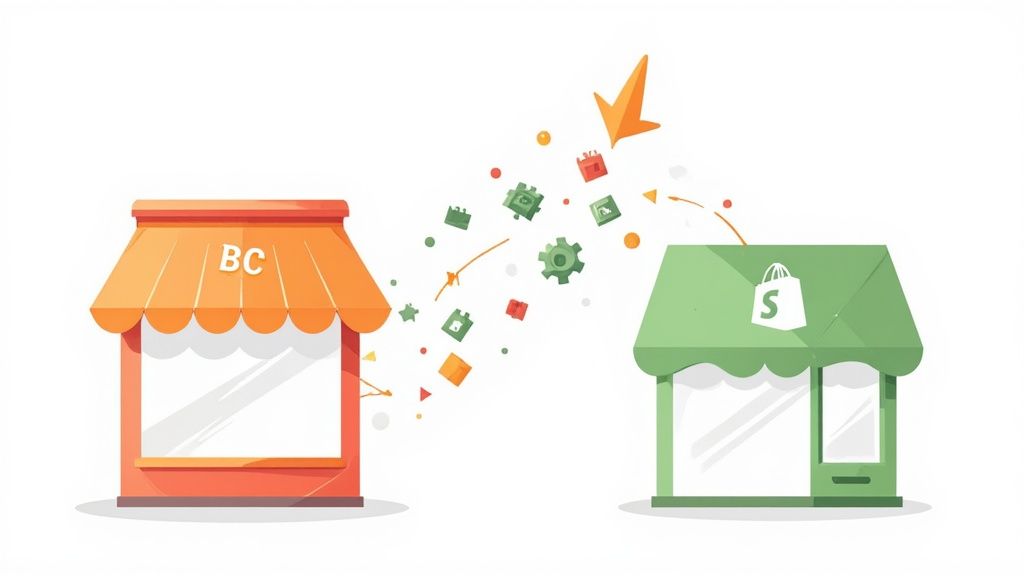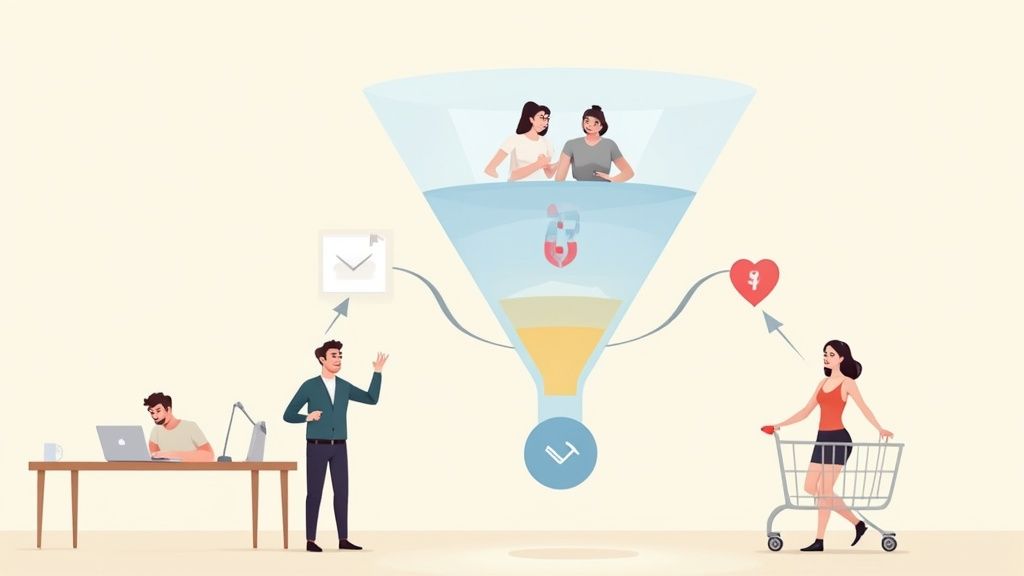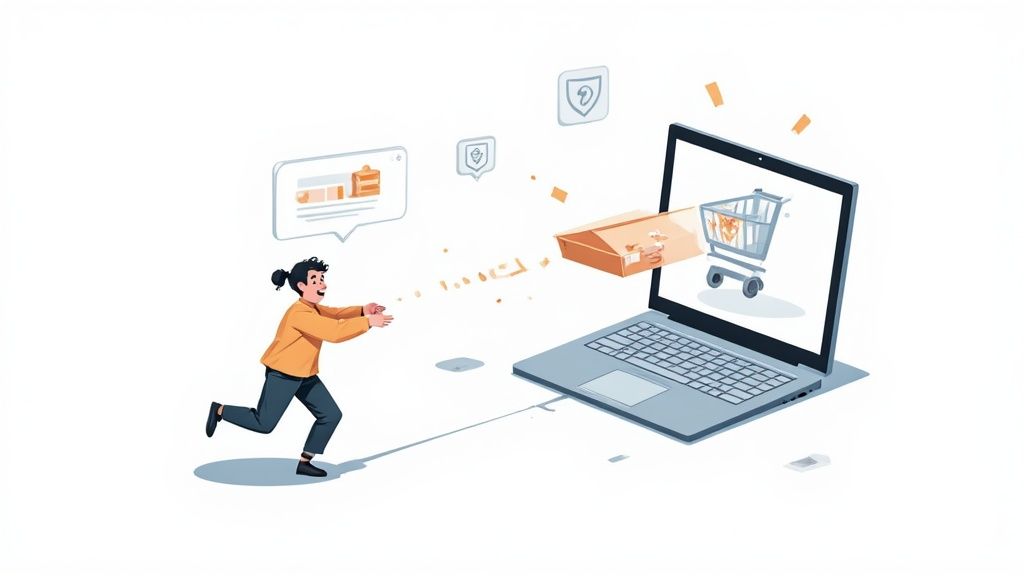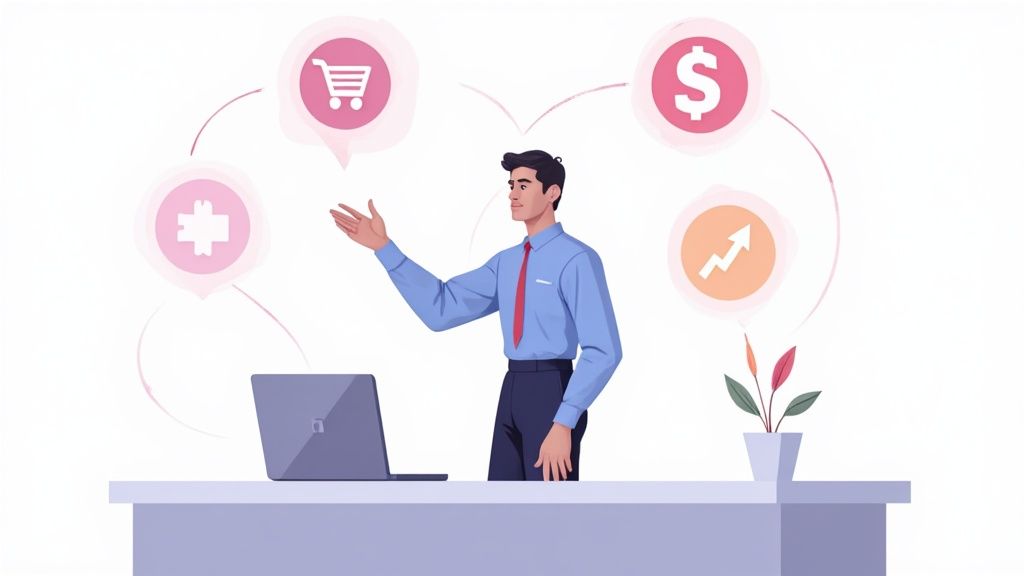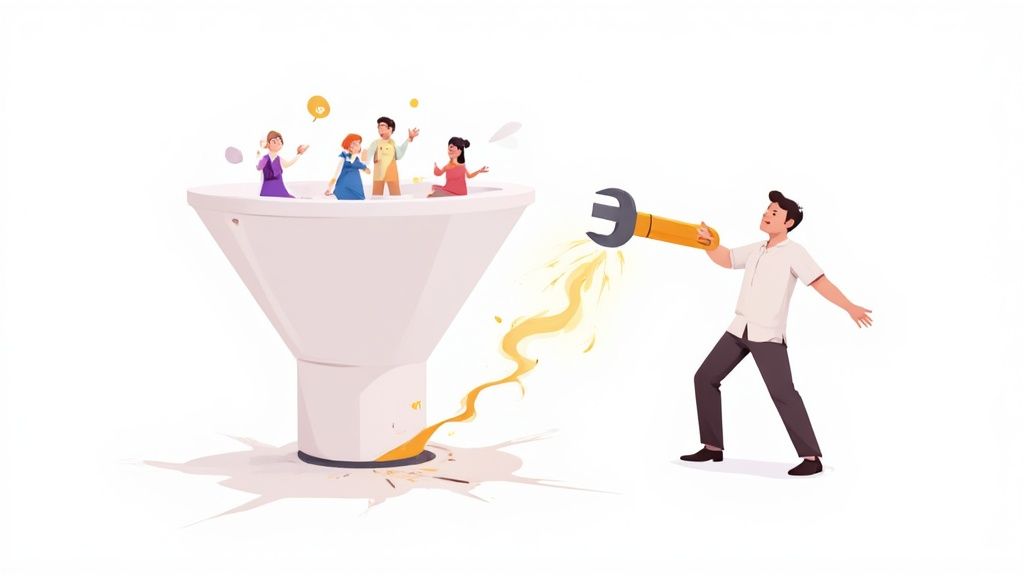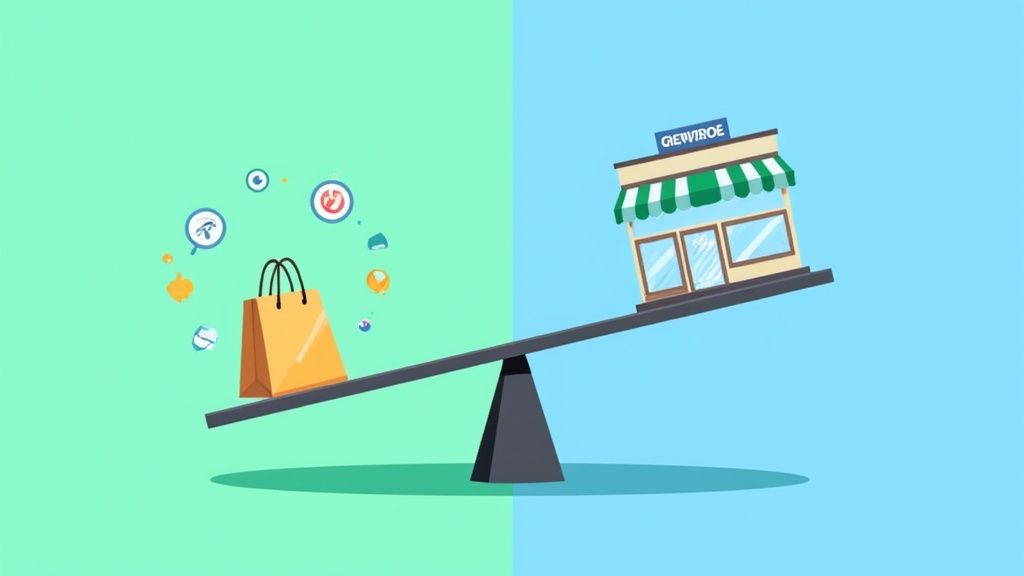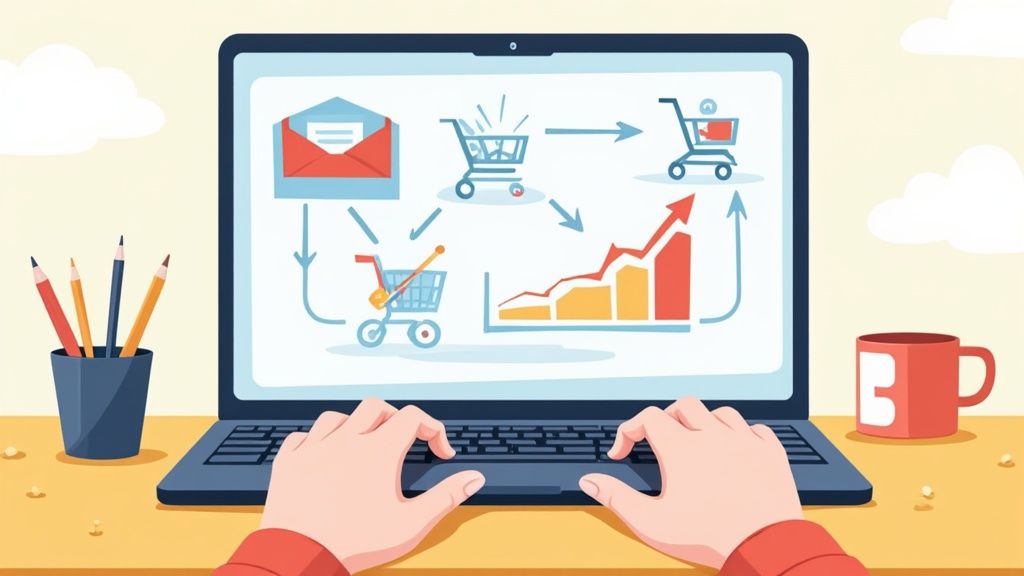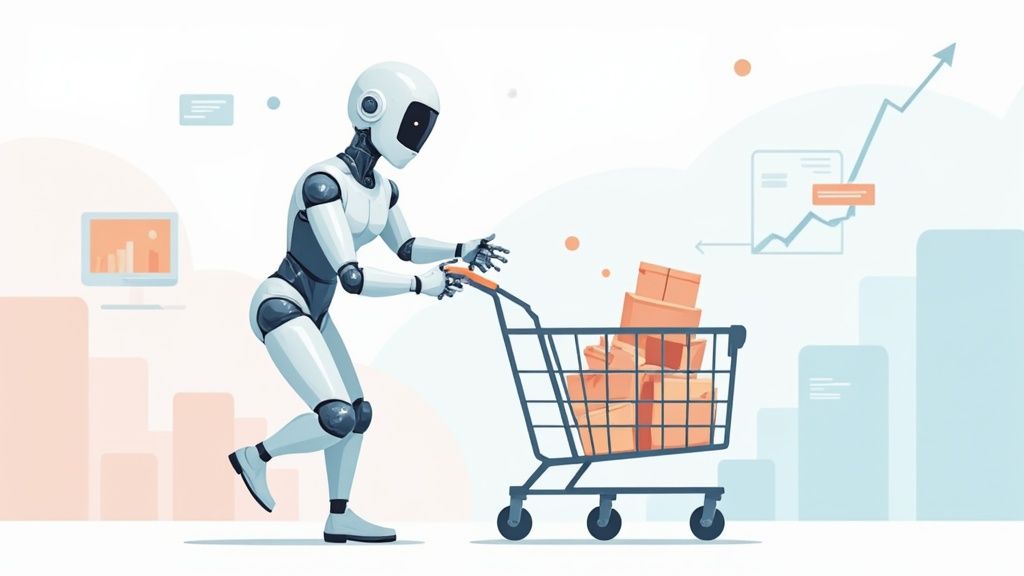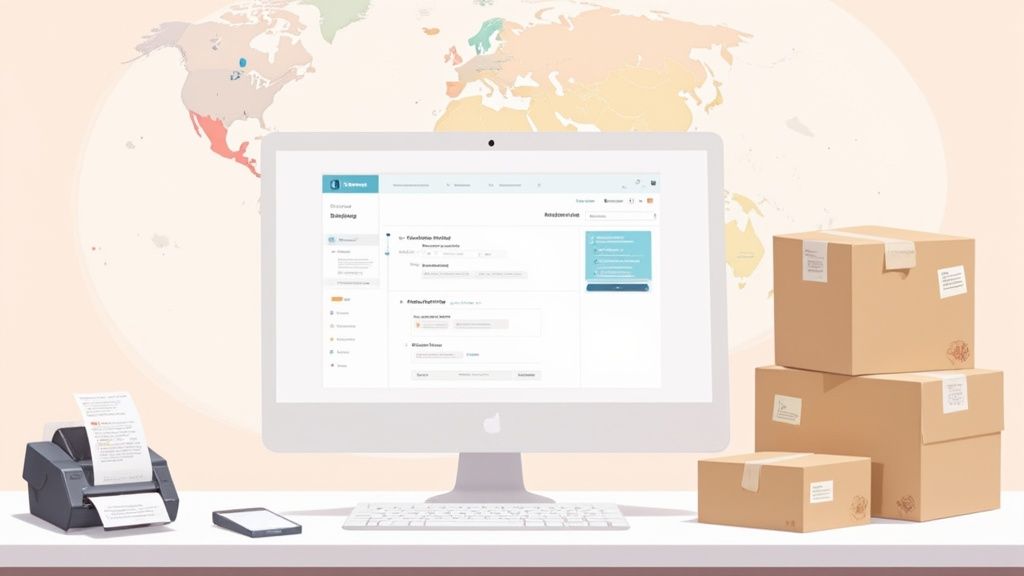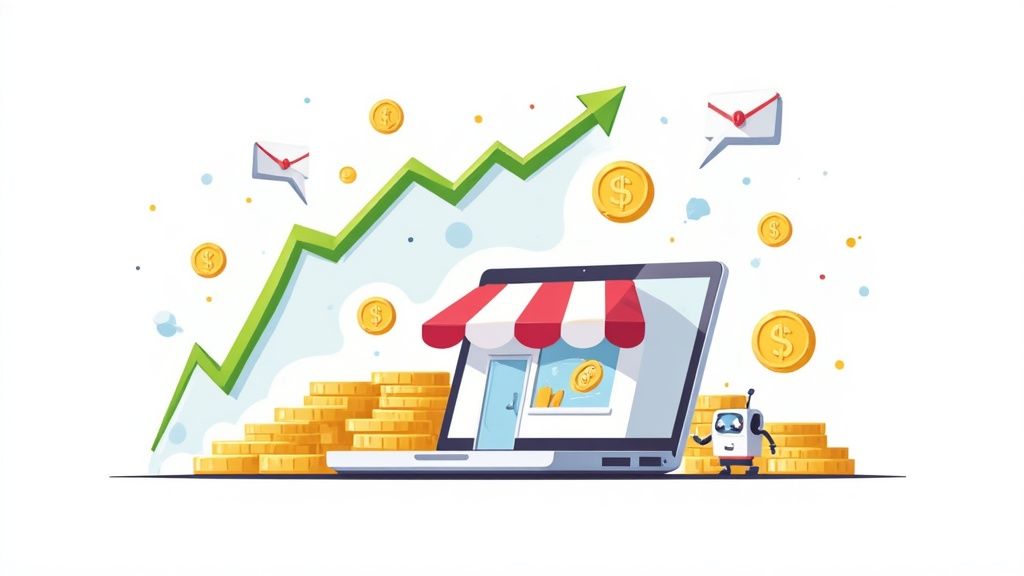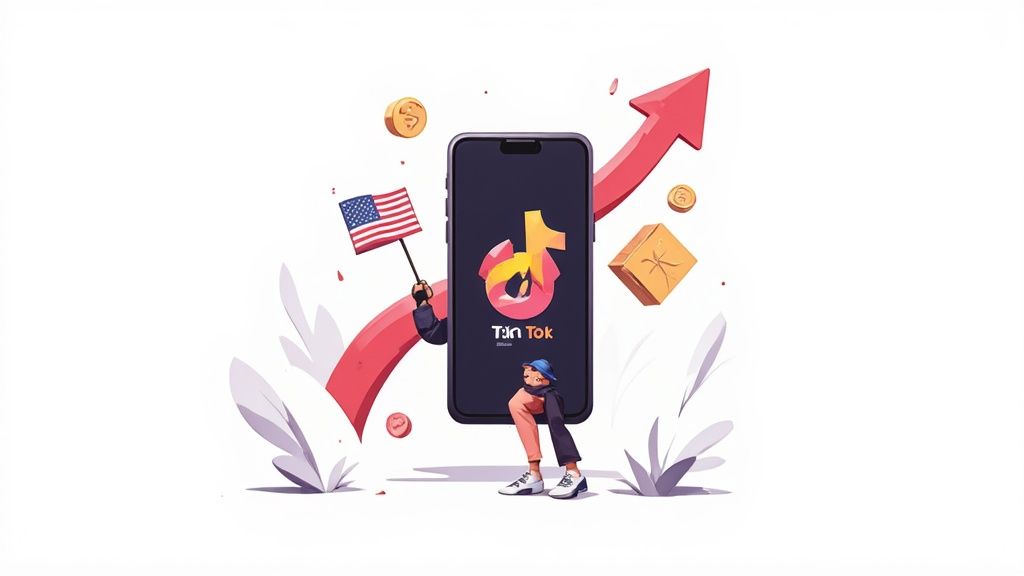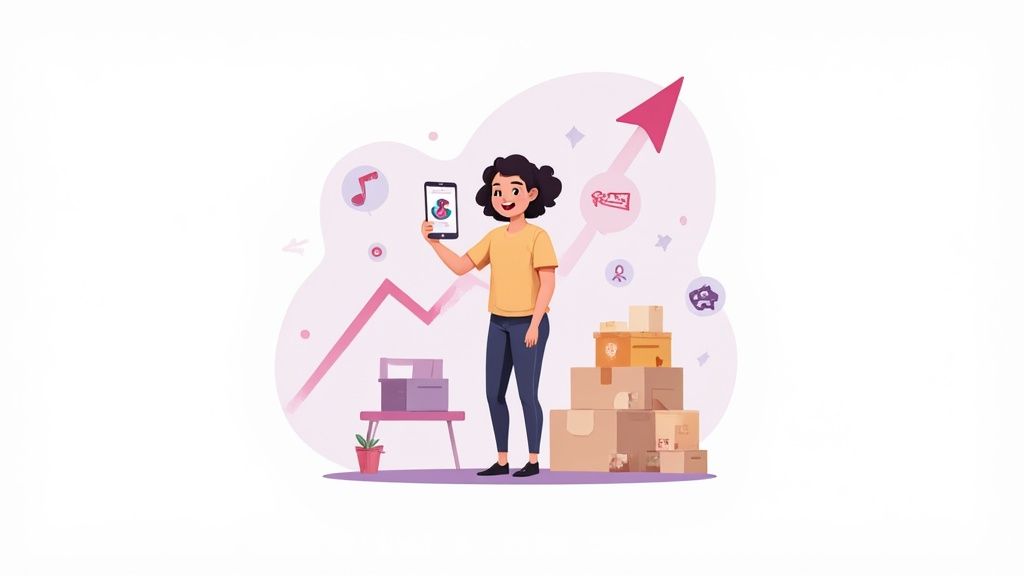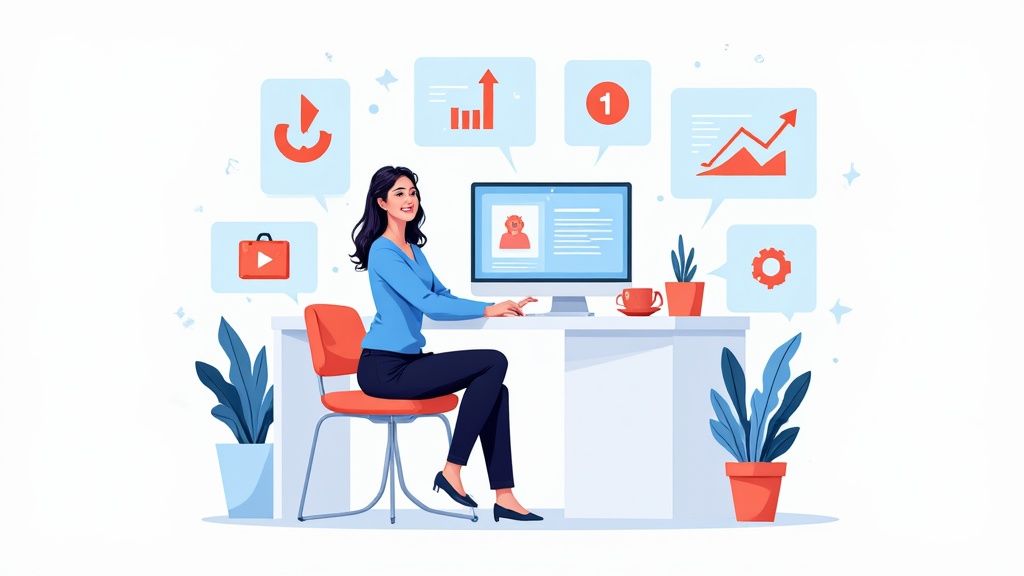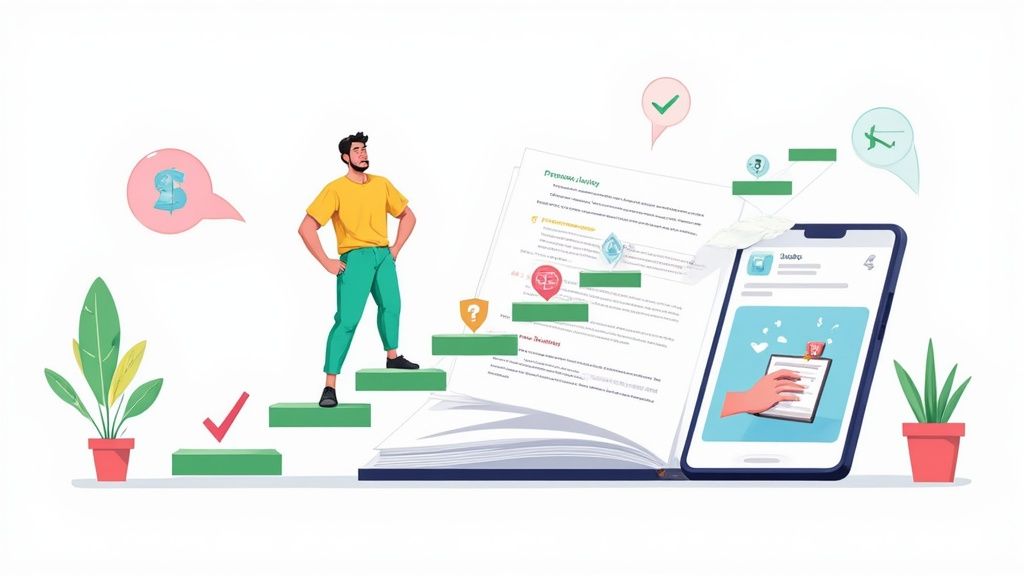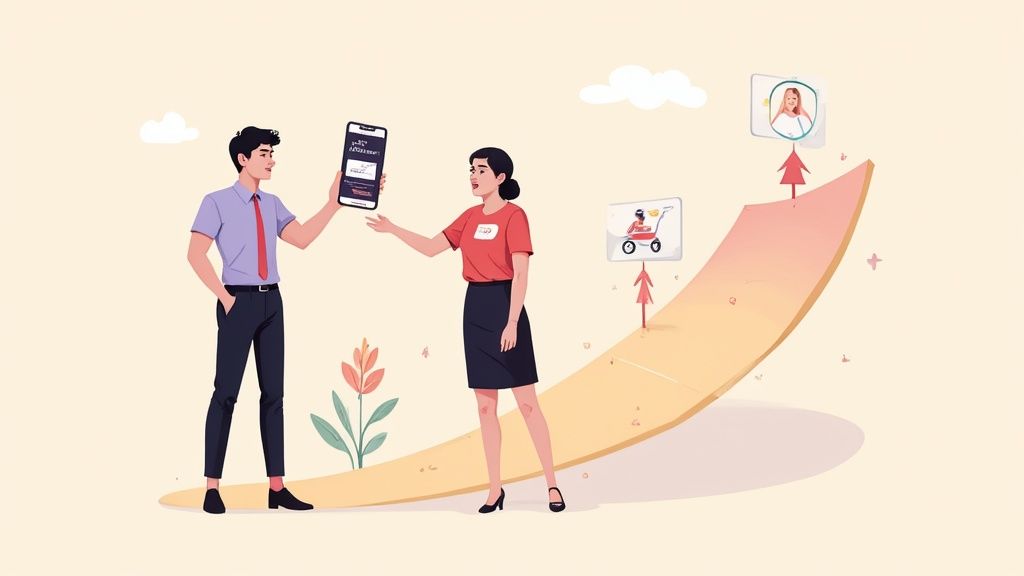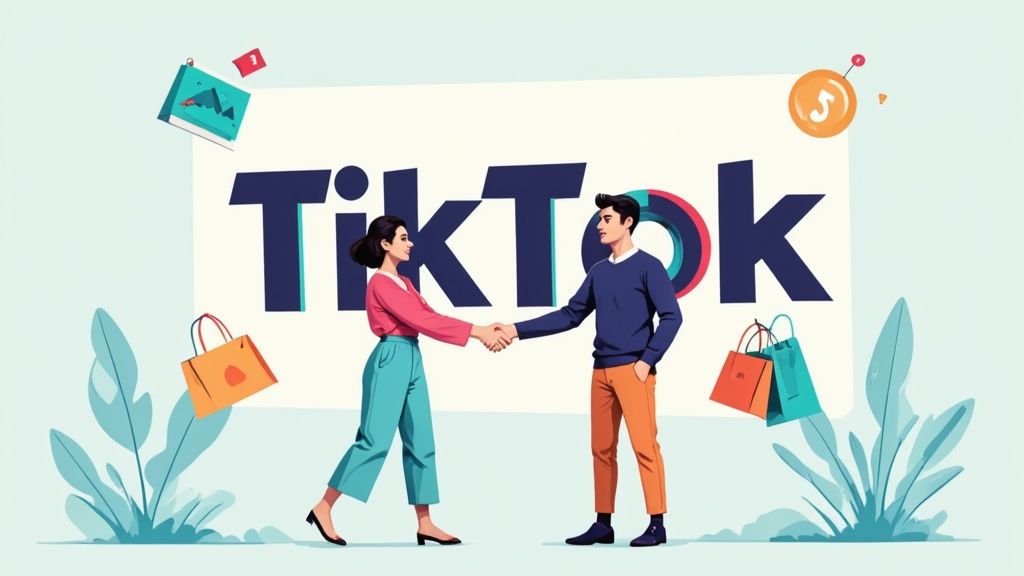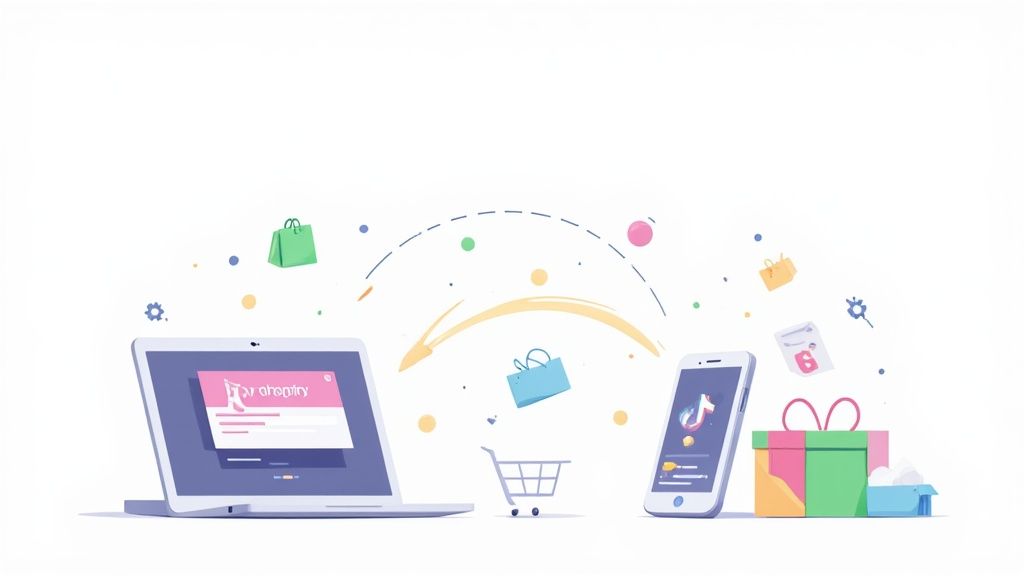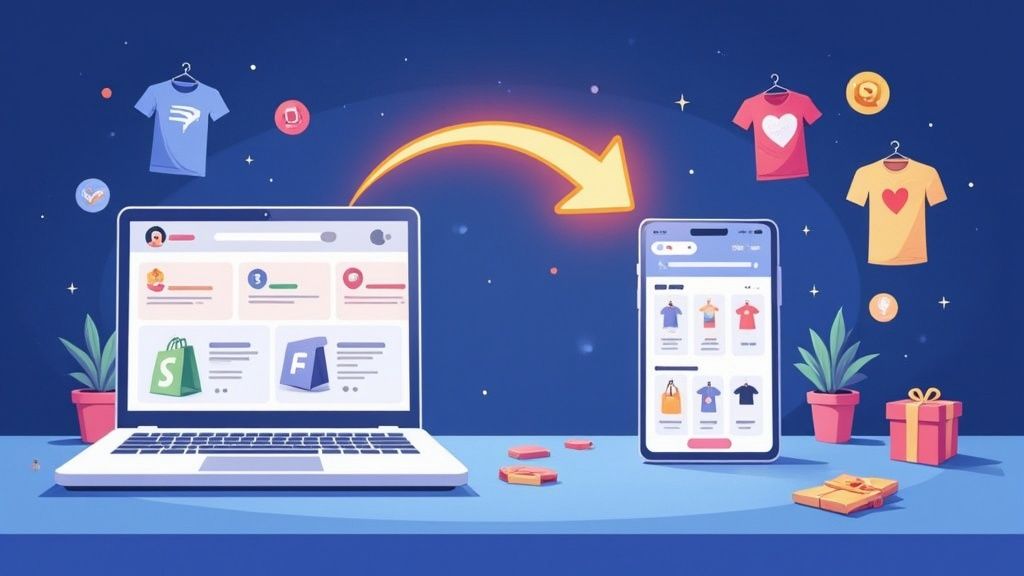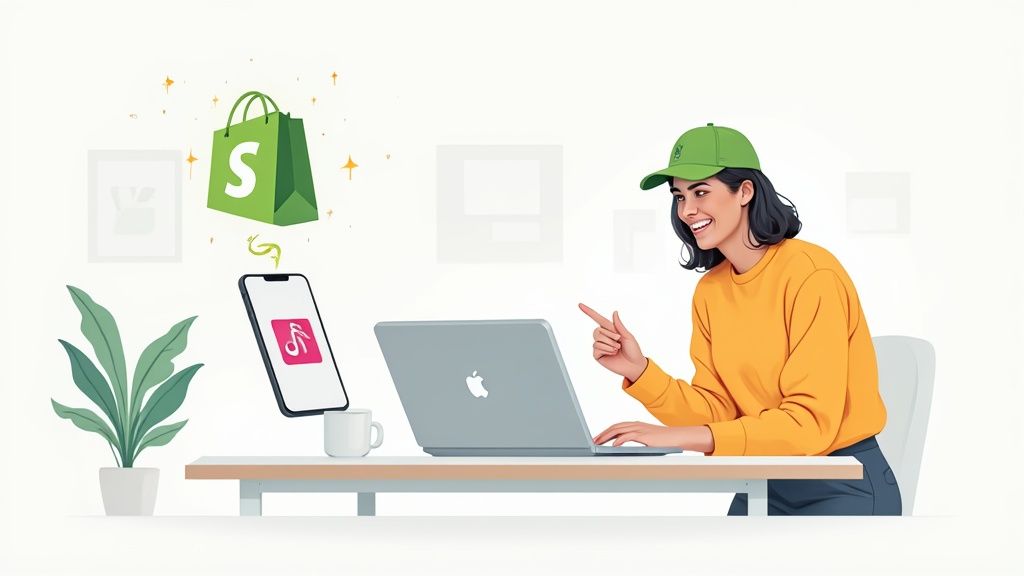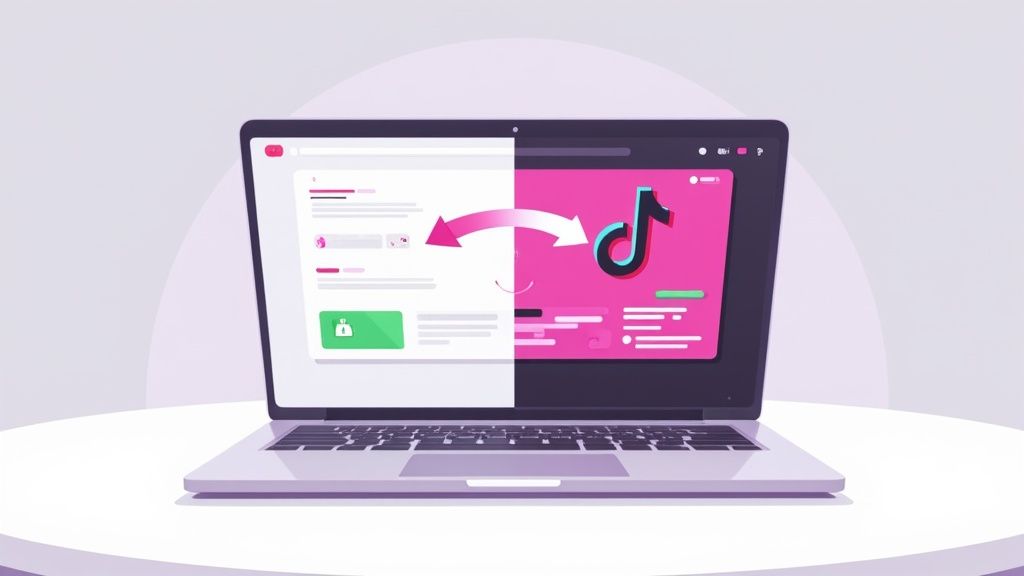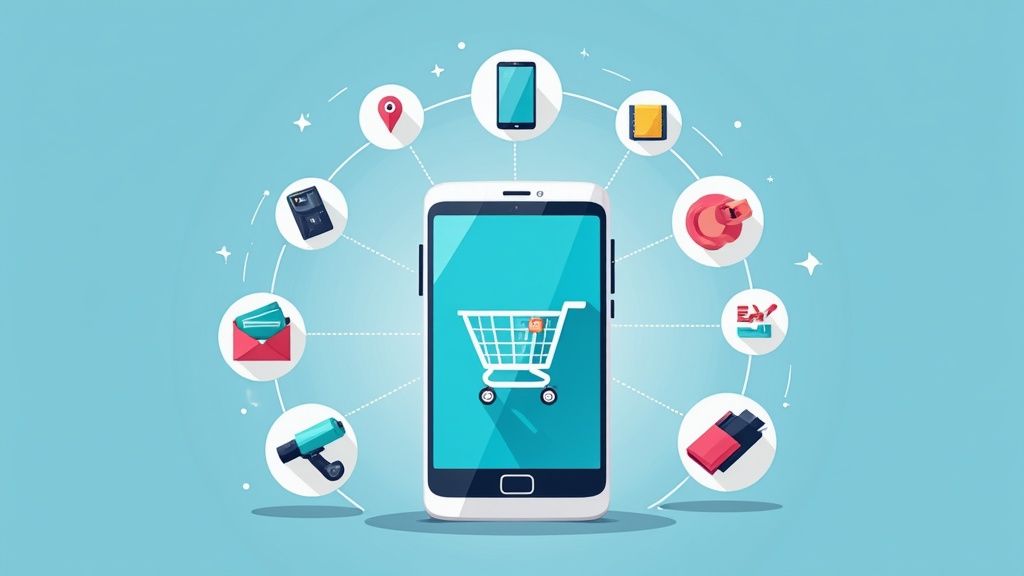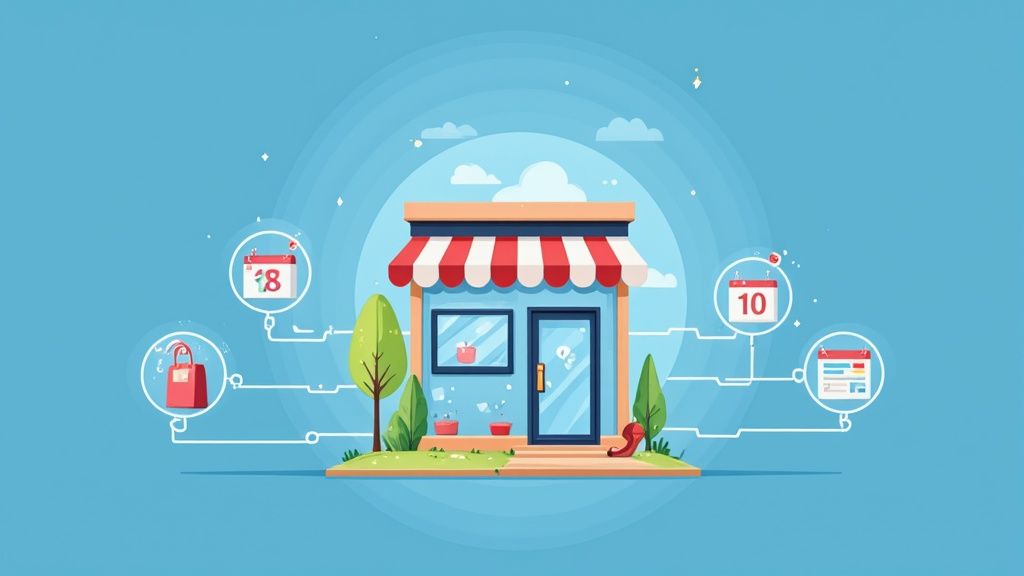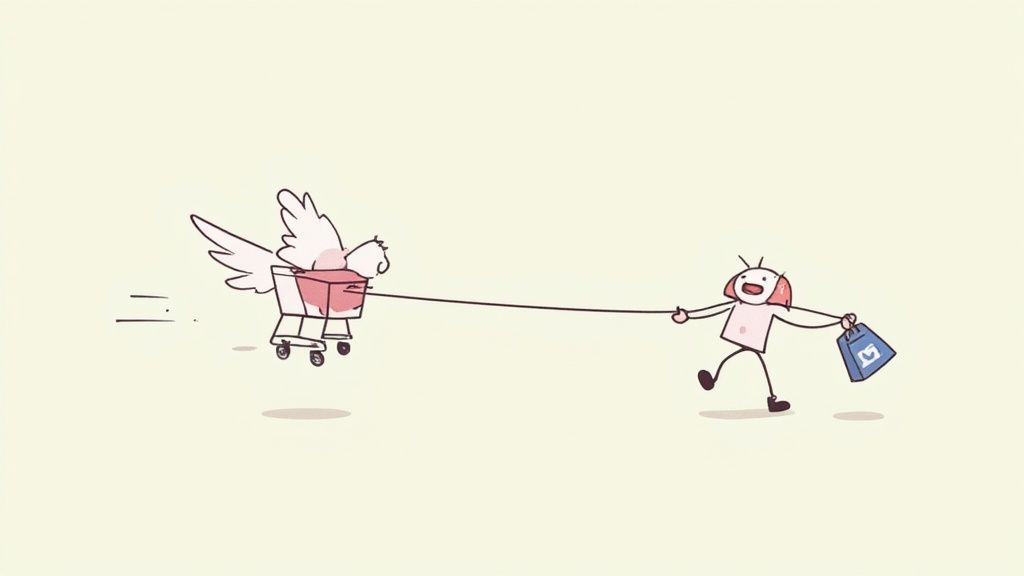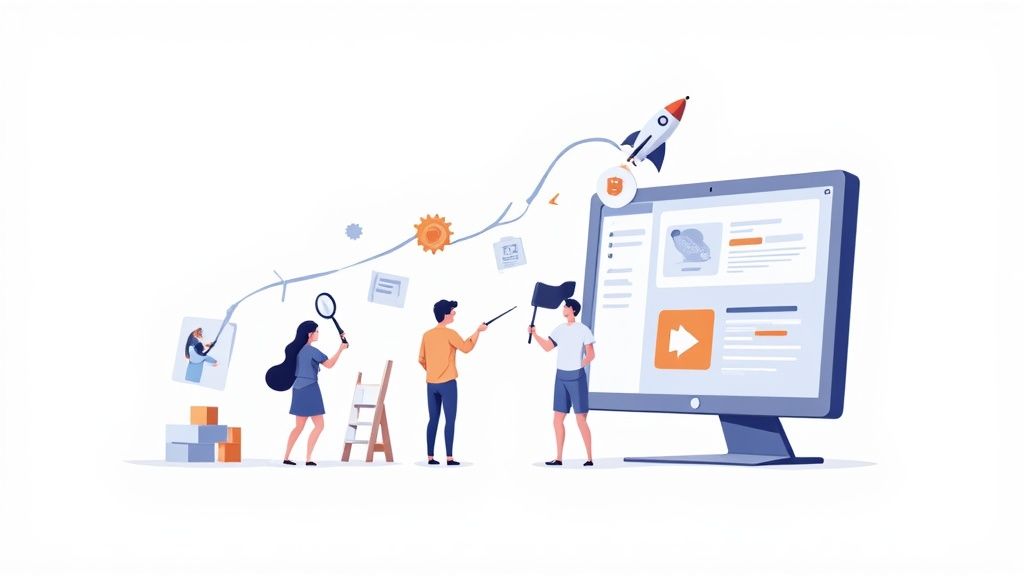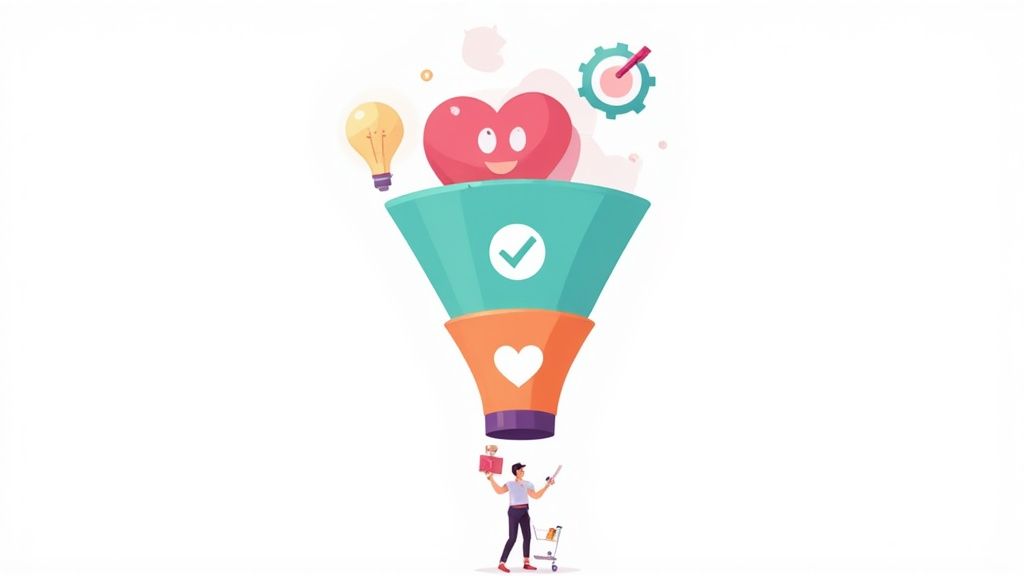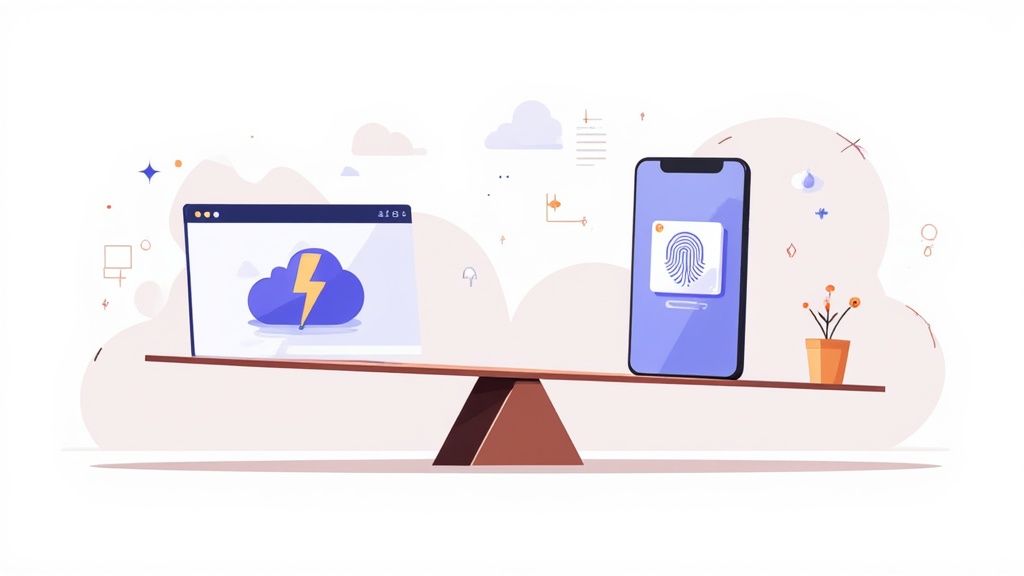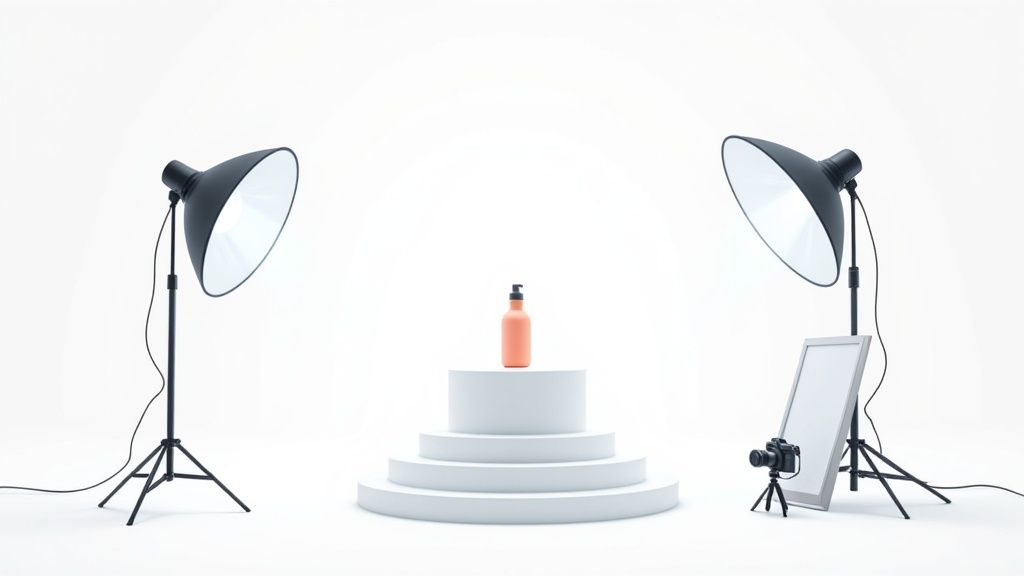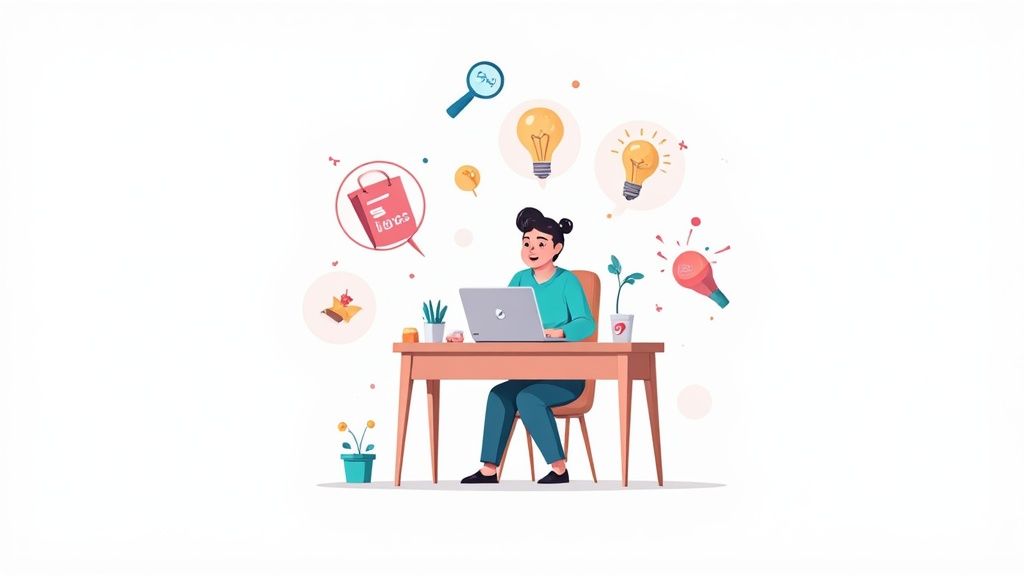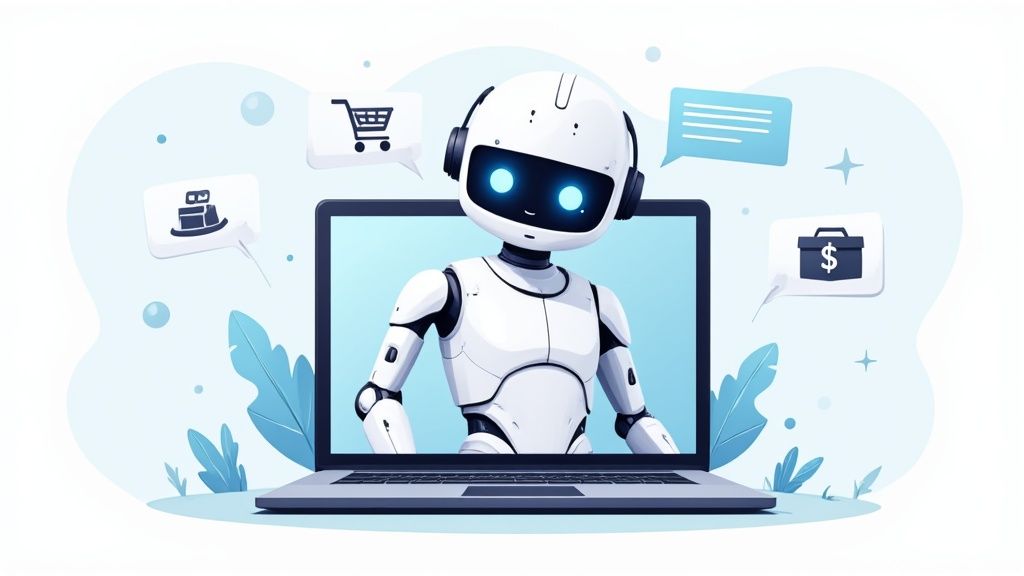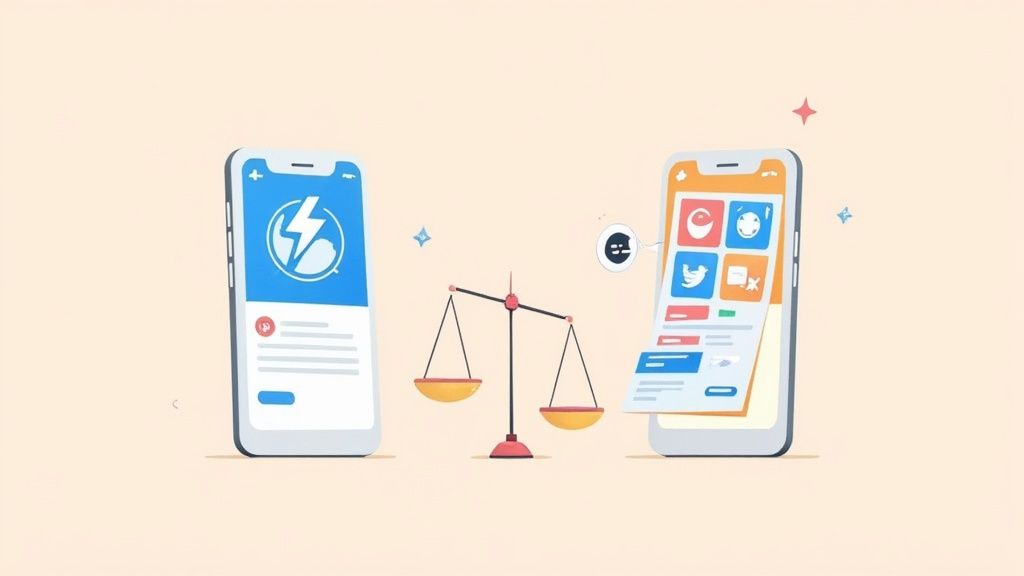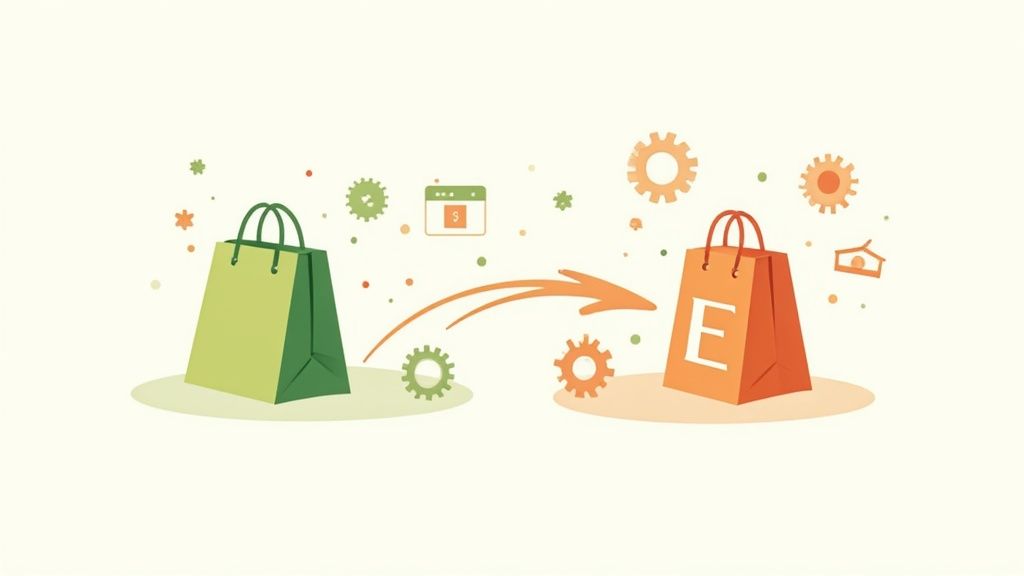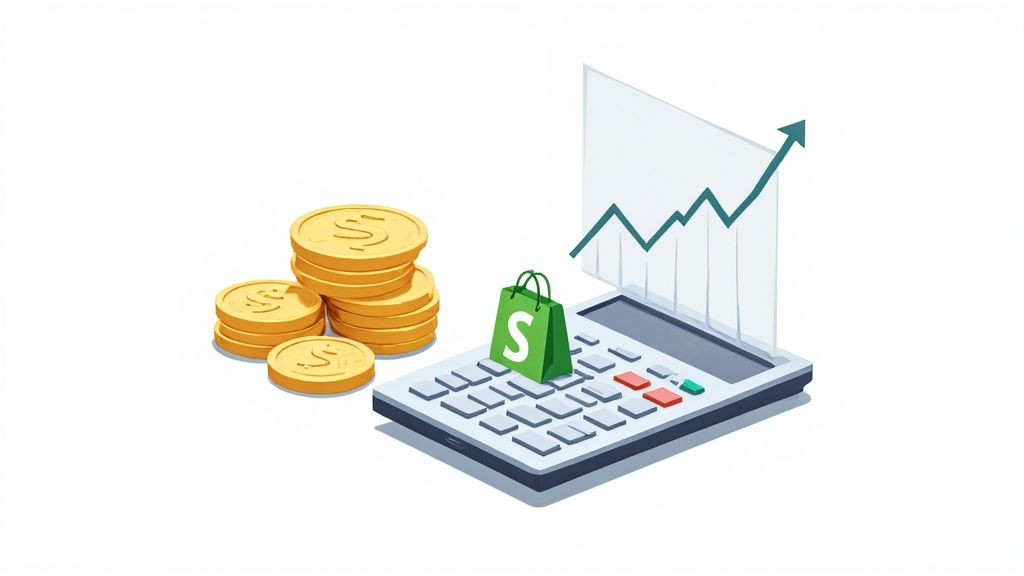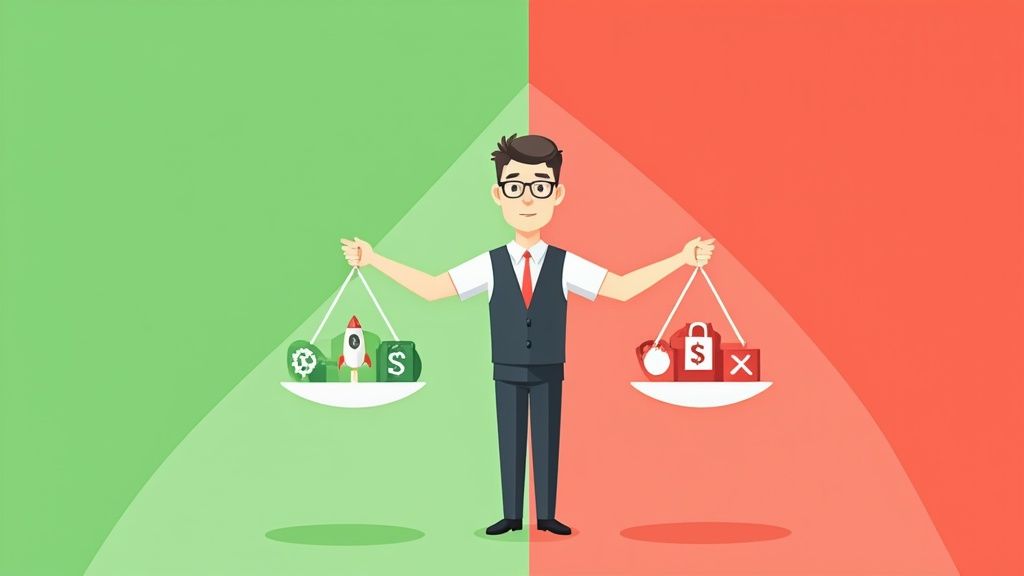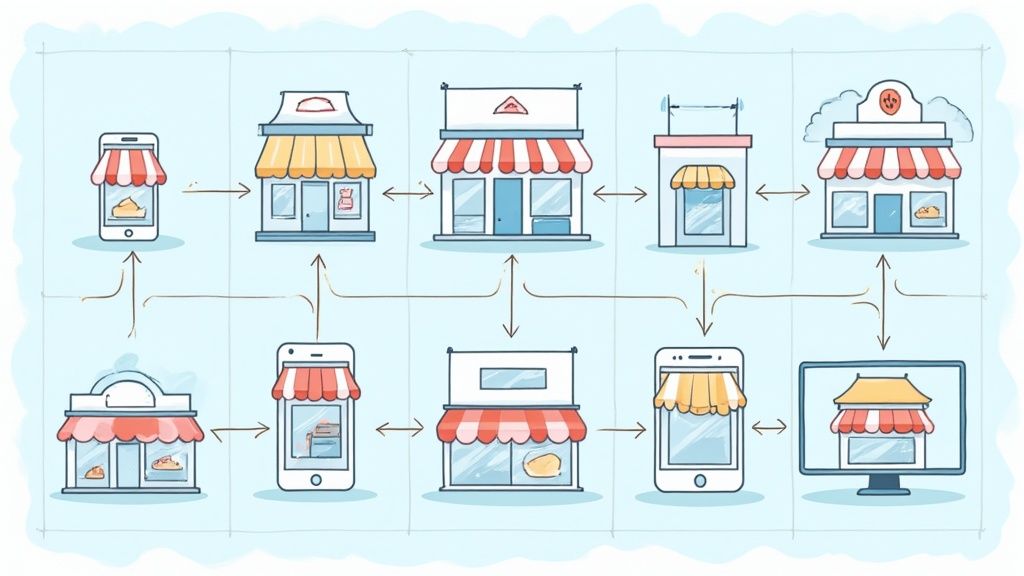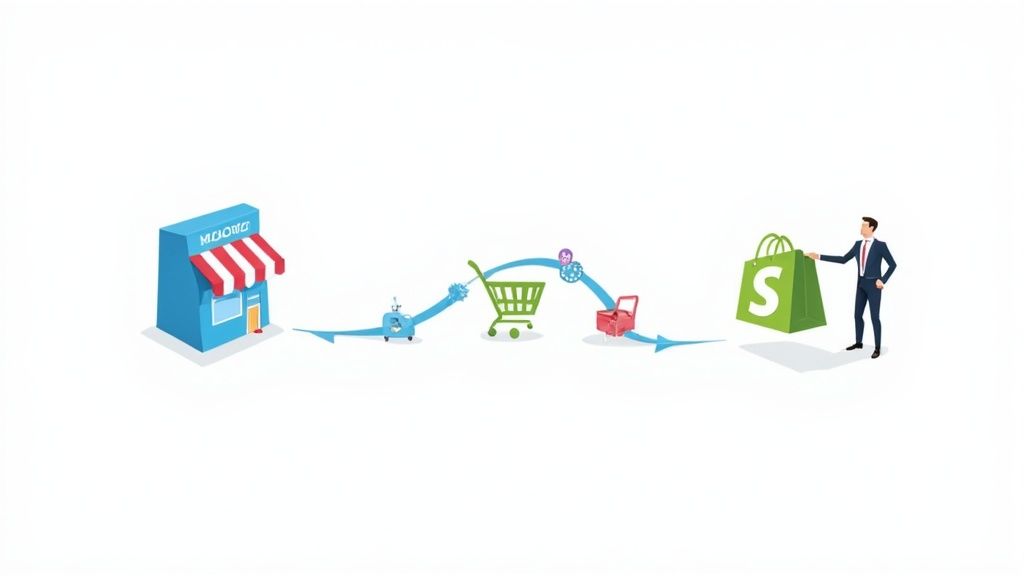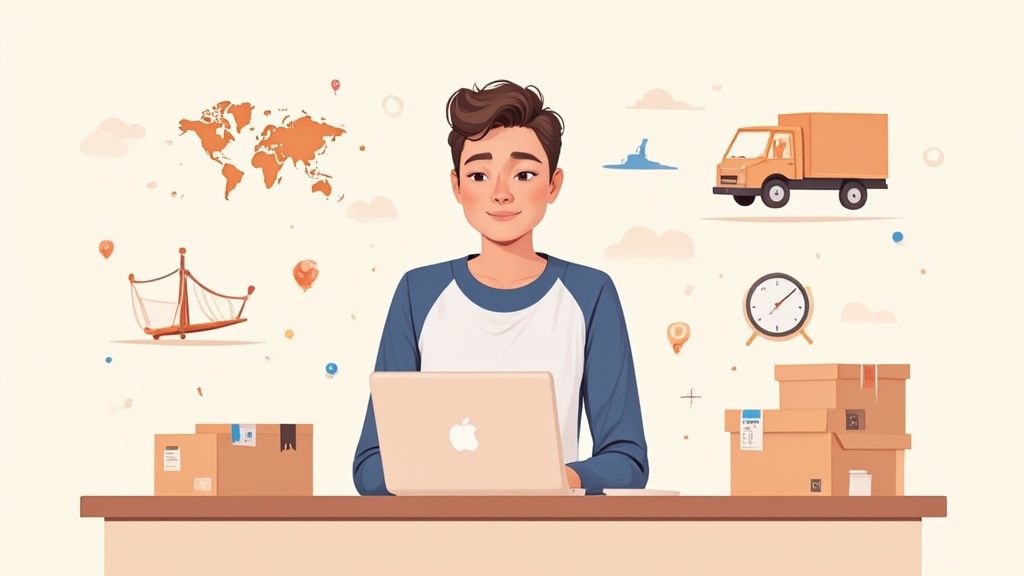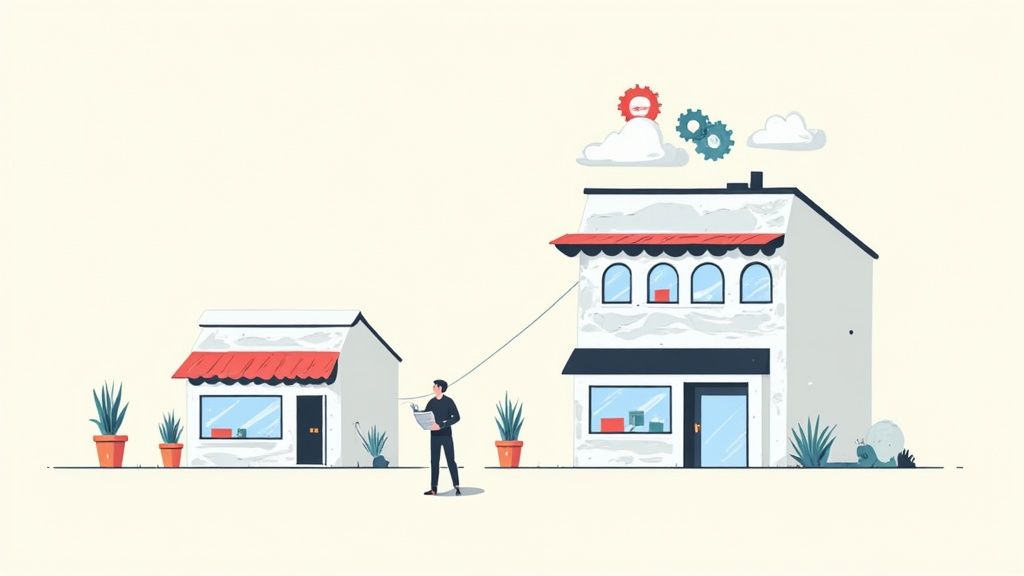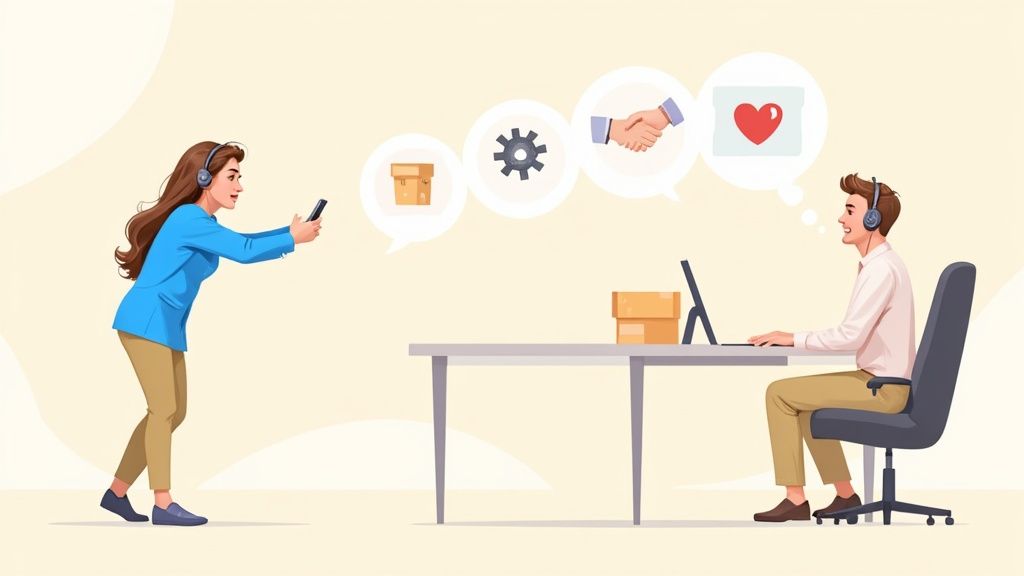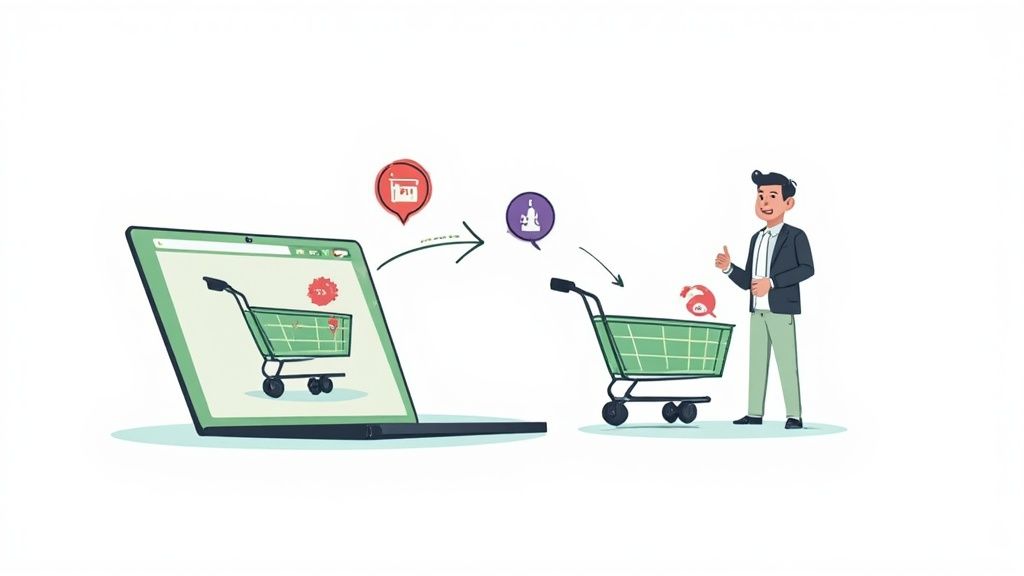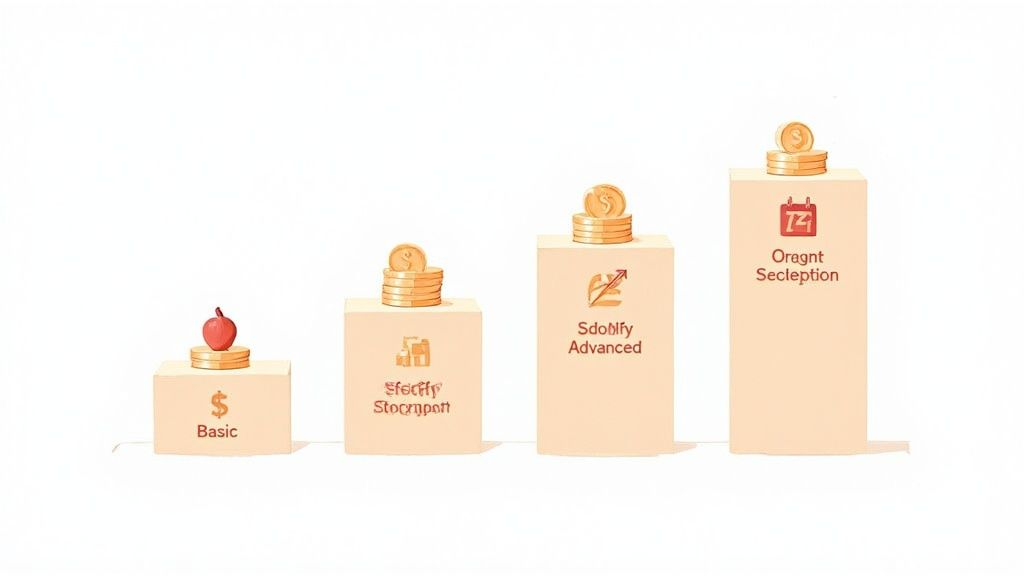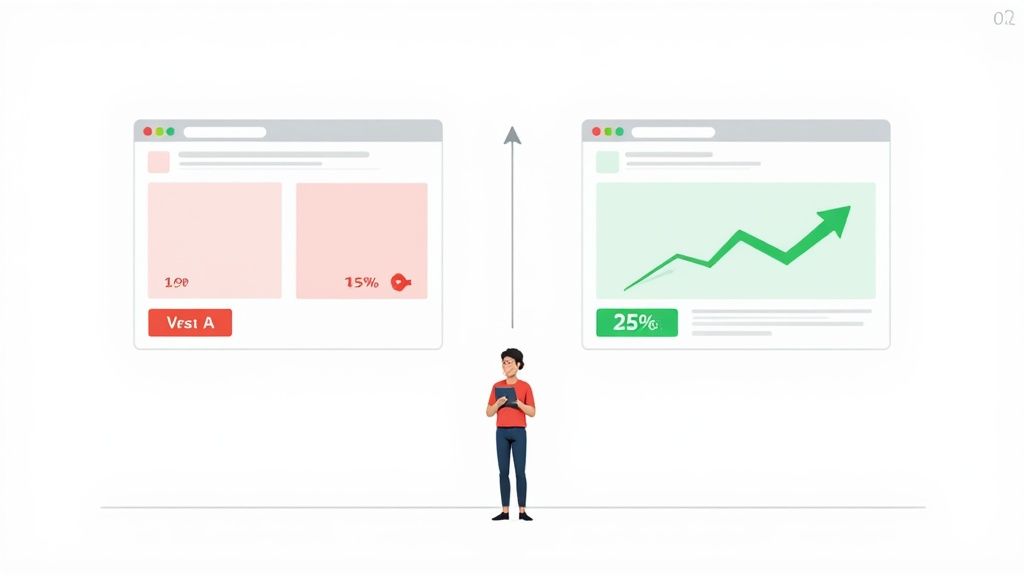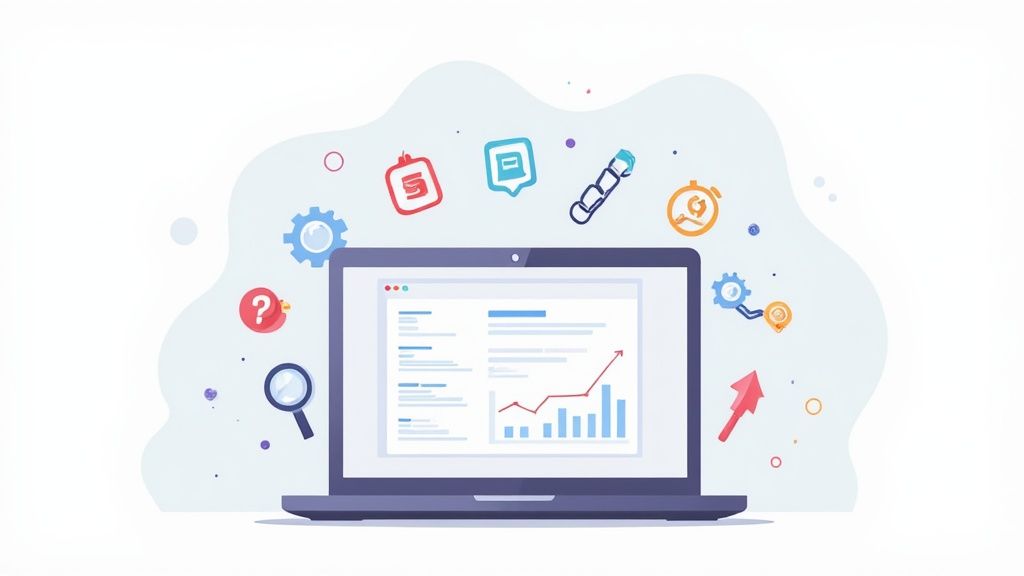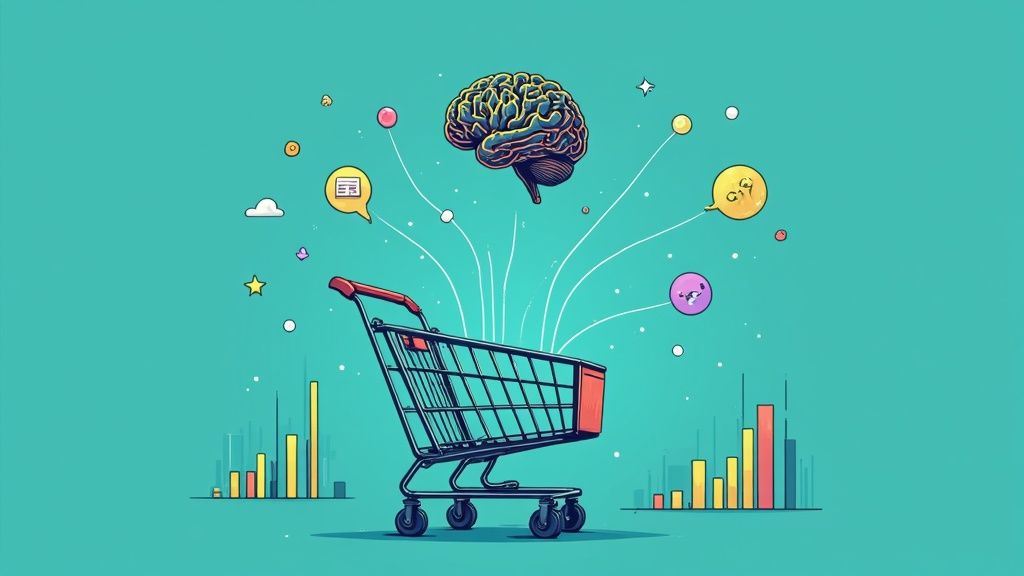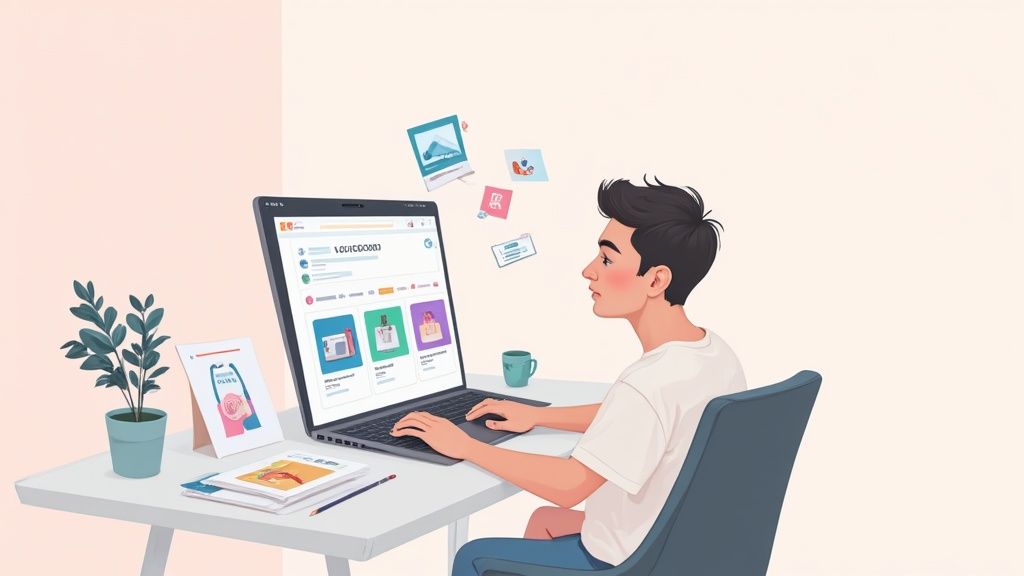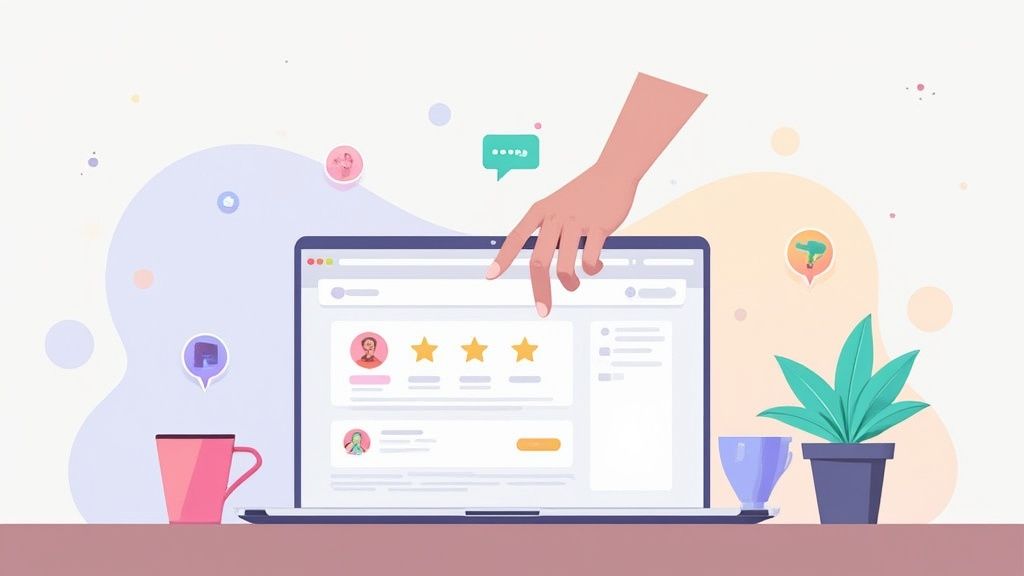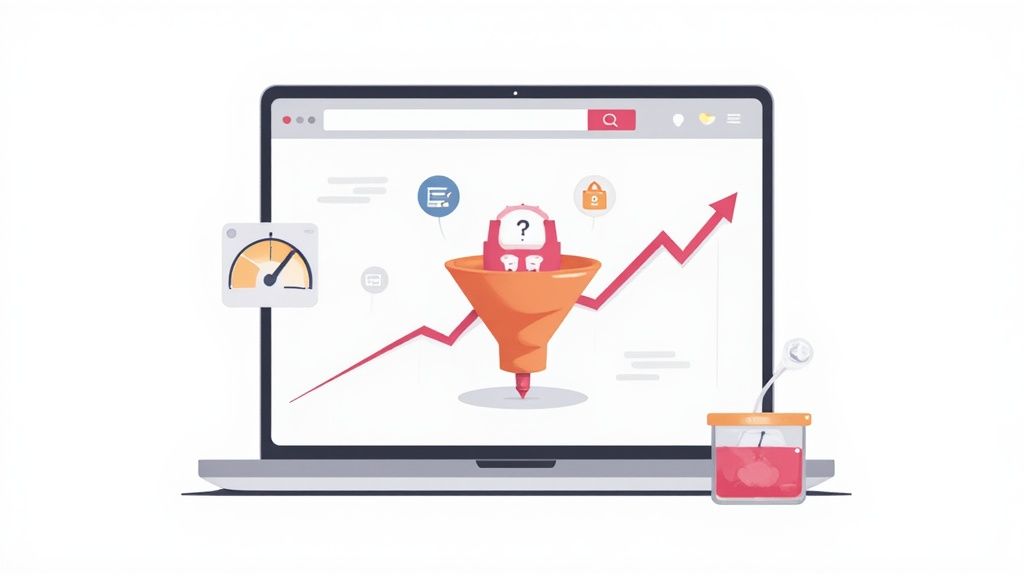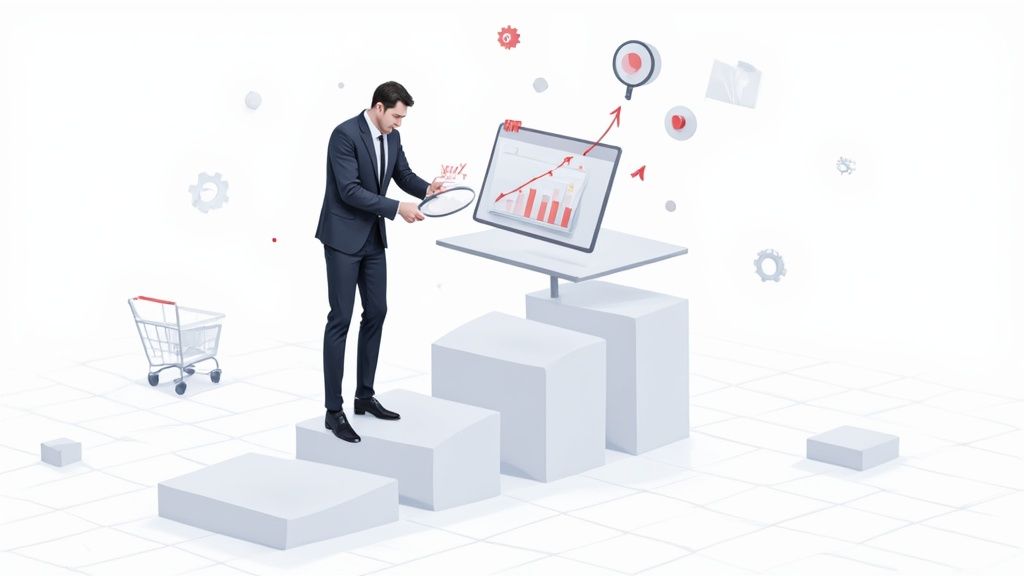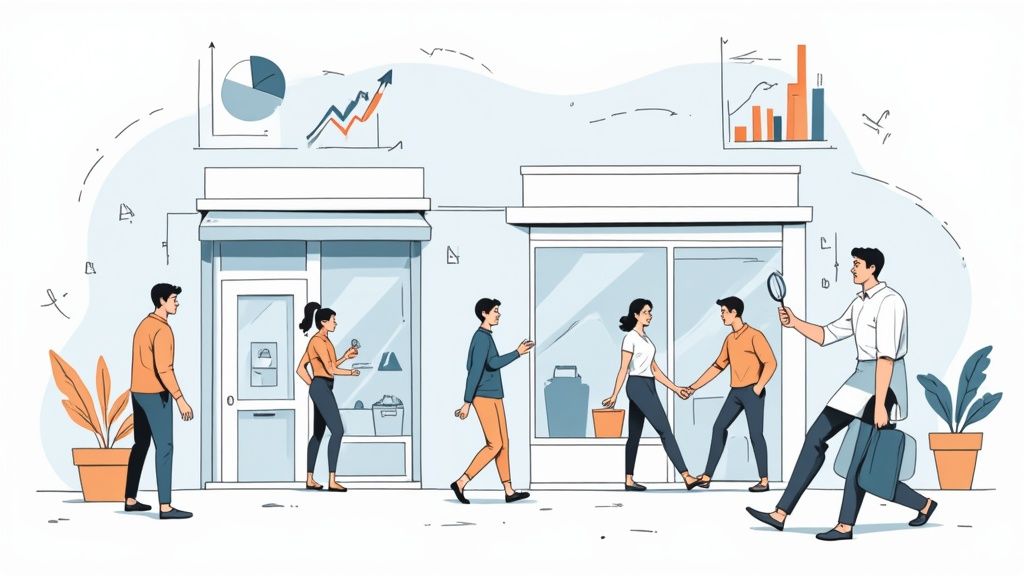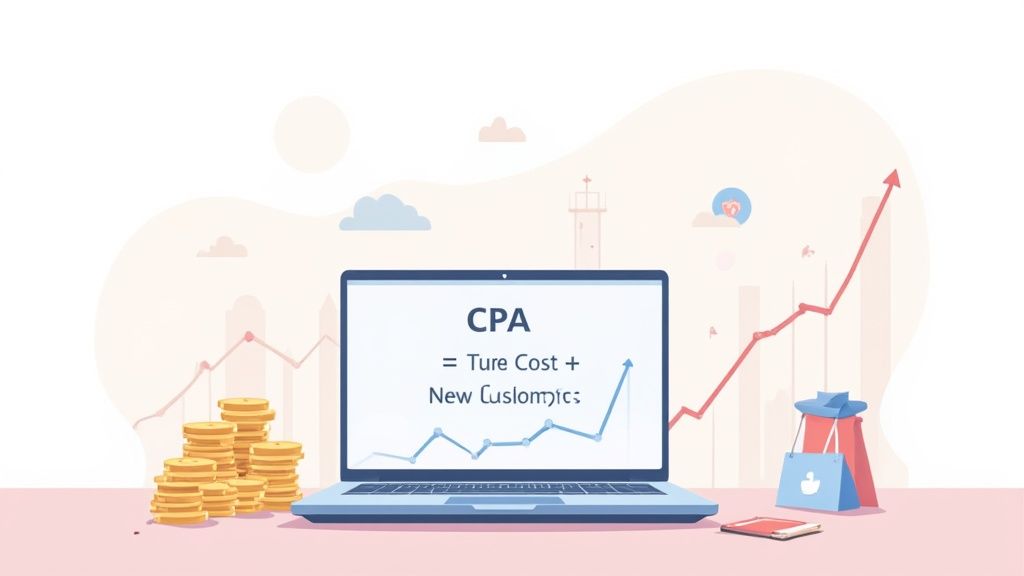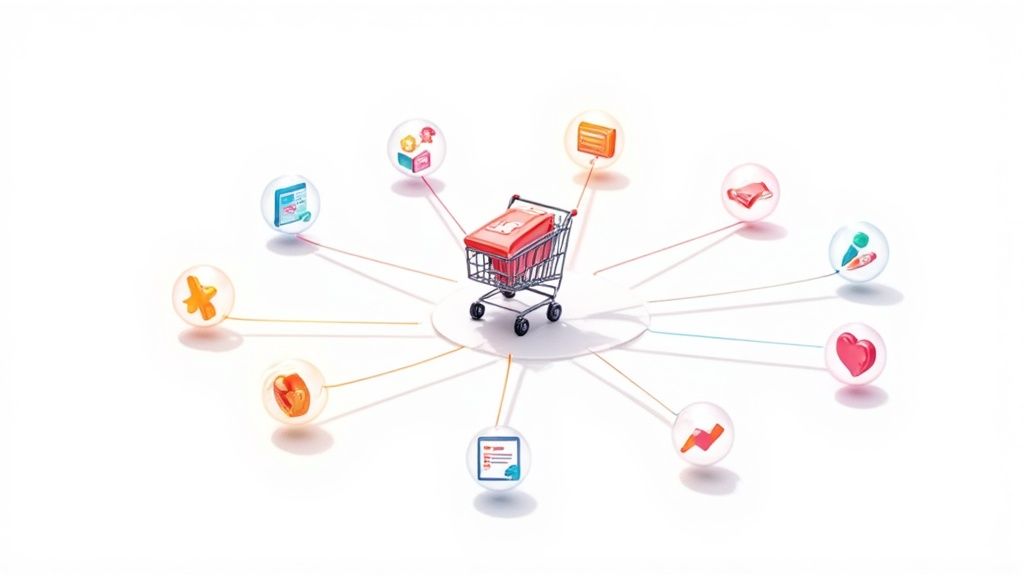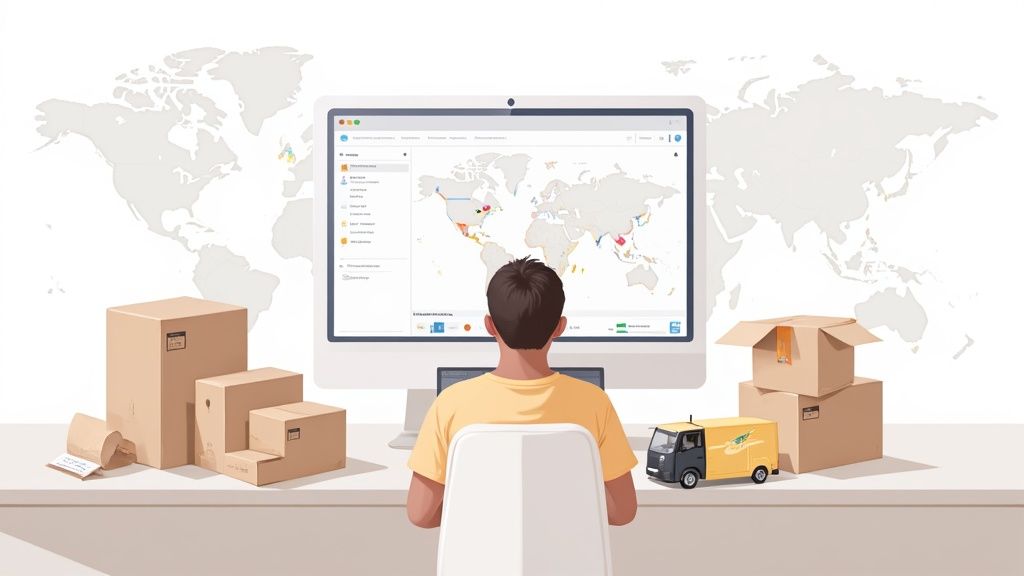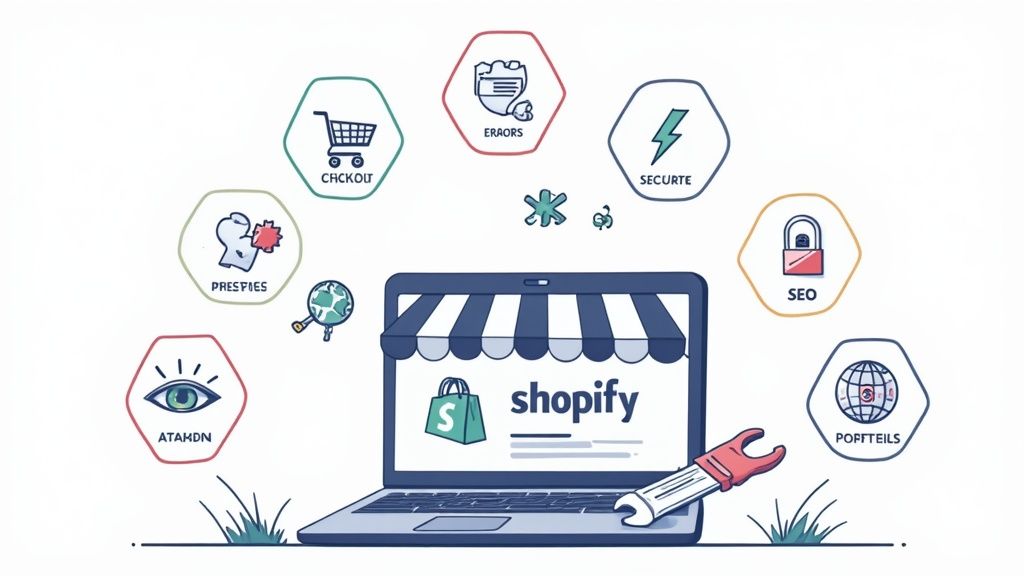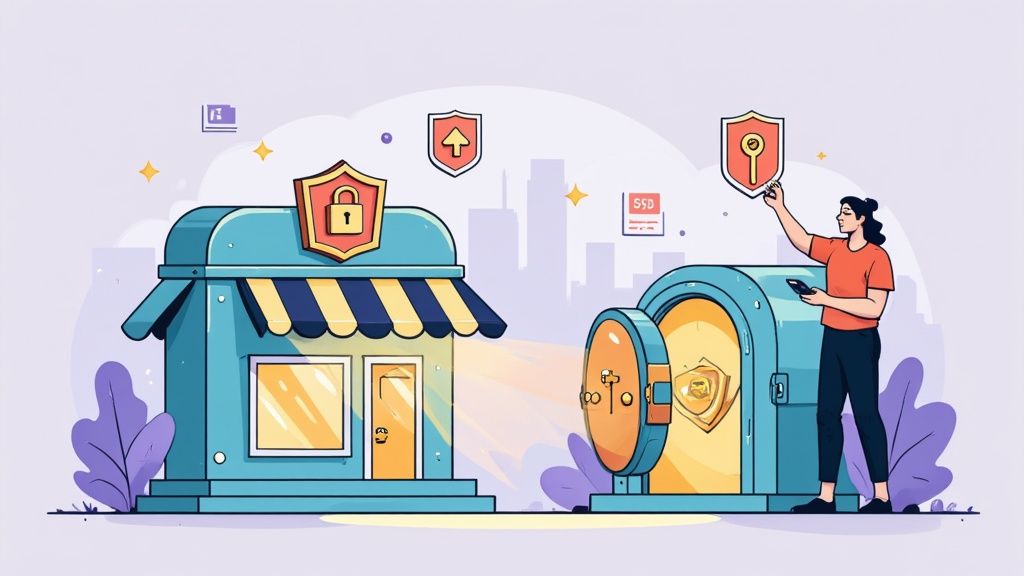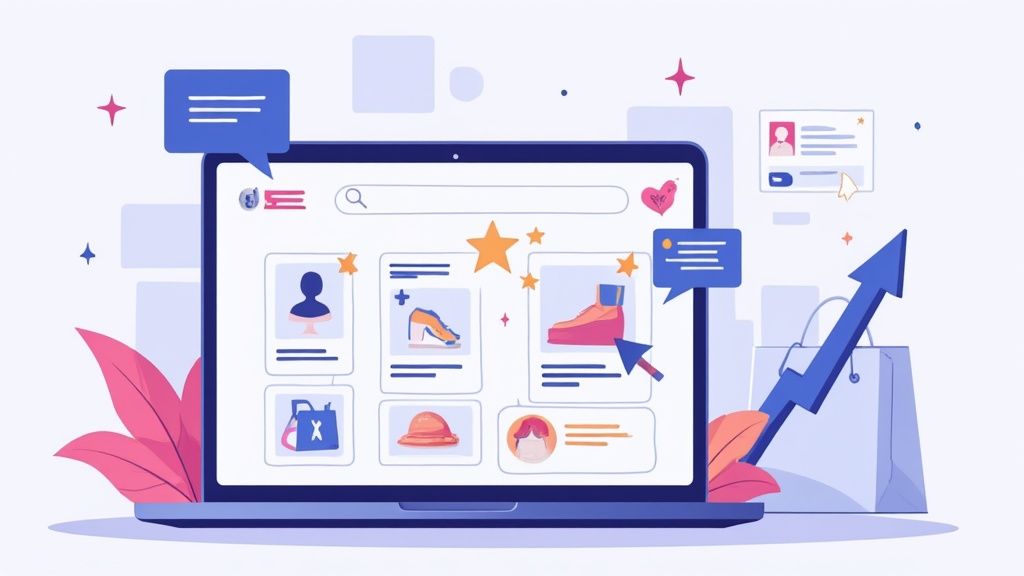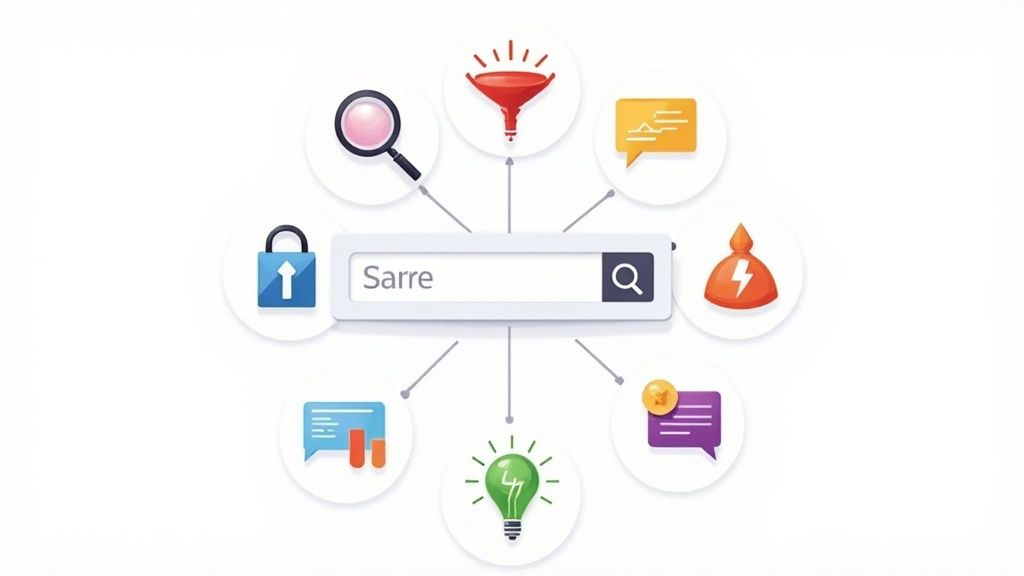
That initial spark of an idea for an online store is an amazing feeling. But let's be real—turning that clever concept into a profitable business can feel like staring up at a mountain. This is where we get our hands dirty and ground your vision in reality.
The goal isn't just to chase a trend. It's about carving out a space where your business can actually put down roots and grow. Building on a solid foundation of data, not just gut feelings, will shape every single decision you make, from the products you source to the tone of your very first Instagram post.
And the opportunity right now? It's huge. Starting an eCommerce business today means tapping into a global market that's projected to blow past $6.86 trillion in sales in 2025. By 2027, experts are forecasting an unbelievable $8 trillion in global sales, leaving traditional retail growth in the dust. You can dive deeper into what these trends mean for new businesses over on SellersCommerce.com.
From Idea to Actionable Business Concept
So, where do you start? The first, and maybe most important, step is nailing down a profitable idea.
Find Your Profitable Niche
One of the most common pitfalls is choosing a niche that's way too broad. "Sustainable fashion," for example, is a movement, not a niche you can own. A much stronger starting point would be something like "eco-friendly denim for petite women" or "vegan leather bags made from recycled materials."
A laser-focused niche lets you become the absolute go-to expert for a very specific audience.
Think about where these three things overlap:
- Your Passion: What could you talk about all day? You're going to be living and breathing this business, so genuine interest is a must.
- Audience Demand: Are people actually out there searching for these kinds of products? Tools like Google Trends or keyword planners are your best friends for validating real-world interest.
- Profit Potential: Can you actually make money here? Look at sourcing costs and figure out if you can sell products at a price that leaves you a healthy margin.
Let's say you love gardening. You could open a generic gardening store, sure. But niching down to "hydroponic systems for urban apartment dwellers" targets a specific person with a specific problem and the money to solve it. See the difference?
Analyze the Competitive Landscape
Once you have a niche in mind, it's time to do some recon. Who’s already selling in this space? Competitive analysis isn't about copying what others are doing—it's about spotting the gaps they've completely missed.
Don't just glance at their products. Dig into their entire customer experience.
"Your niche is what makes you special and what sets you apart. There are thousands of others out there doing exactly what you’re doing. Every decision you make in your business will build upon your niche."
Pick your top 3-5 competitors and ask yourself some hard questions:
- What's their unique selling proposition (USP)? Are they the cheapest? The highest quality? The most eco-conscious?
- Who are they really talking to? Read their blog posts, their social media captions, their "About Us" page. What kind of language are they using? Who are they trying to attract?
- Where are they dropping the ball? This is gold. Scour their product reviews. Are customers constantly complaining about slow shipping, poor quality, or a website that's a nightmare to navigate? Those are your opportunities.
Define Your Ideal Customer
You can't sell to "everyone." It just doesn't work. One of the most powerful things you can do early on is create a detailed customer persona—a fictional profile of your ideal buyer.
Get specific. Give them a name, an age, a job, and a personality.
Let’s go back to those hydroponic systems. Your ideal customer might be "Alex," a 32-year-old software developer living in a small city apartment. Alex is passionate about sustainability, loves fresh, healthy food, but has zero outdoor space.
This simple profile instantly tells you how to market your product. Alex probably reads tech blogs and scrolls Instagram, appreciates product descriptions backed by data, and would be drawn to a clean, modern brand design. Suddenly, you're not building a business for a faceless market; you're building it for a real person.
Choosing Your Platform and Legal Structure
You’ve got a solid, validated idea. Now it's time to build the foundation. The next two decisions—your technology and your legal setup—will shape how your business runs for years. Get these right now, and you'll save yourself a world of headaches down the road.
Selecting the Right Ecommerce Platform
Think of your ecommerce platform as the engine for your online store. It's what powers everything from your product pages and shopping cart to payments and order fulfillment. The market is packed with options, but for most new businesses, the choice usually boils down to three major players.
Let's imagine you're a boutique owner selling custom, hand-painted jackets. Your priority is a visually stunning storefront that's easy to manage yourself, with dead-simple integrations for marketing on Instagram. For this kind of business, Shopify is almost always the perfect fit. It’s famous for its clean, user-friendly interface and beautiful themes that let you look professional without knowing a single line of code.
Now, picture a high-volume dropshipper selling hundreds of different electronic gadgets. Their focus isn't a unique design; it’s powerful inventory management, top-tier SEO features, and the ability to scale without getting crushed by transaction fees. This is where BigCommerce really shines. It packs in a ton of powerful features out-of-the-box that would require paid third-party apps on other platforms.
Finally, consider an entrepreneur who already has a popular blog on WordPress and wants to start selling products. The logical choice here is WooCommerce, which is a plugin that turns a WordPress site into a full-fledged store. It offers incredible customization potential, but it definitely comes with a steeper learning curve. You’re on the hook for your own hosting, security, and updates, making it a better fit for those with some technical confidence.
"Your platform choice is a long-term commitment. Think about where your business will be in two years, not just two months. A platform that feels easy today might feel limiting tomorrow if it can't grow with your ambitions."
Deciding which one is right for you involves balancing your passion with what the market actually wants. This simple decision tree can help you find that sweet spot.

As the infographic shows, the best ideas live where your interests and skills overlap with genuine market demand.
To make this even clearer, here's a side-by-side look at how the top platforms stack up.
Ecommerce Platform Comparison
Choosing your platform is one of the most critical early decisions you'll make. This table breaks down the core differences between the big three to help you see which one aligns best with your business goals, technical comfort level, and budget.
Ultimately, there's no single "best" platform—only the one that's best for you. Shopify gets you started fast, BigCommerce prepares you for scale, and WooCommerce gives you complete freedom.
If you want to dig even deeper into features and costs, check out our complete guide on how to choose an ecommerce platform that truly fits your vision.
Deciding on a Legal Business Structure
This part might sound dry, but it's all about protecting yourself. Your business structure defines your personal liability and how you'll handle taxes. For most new ecommerce founders, the decision boils down to two main options.
Sole Proprietorship
- What it is: This is the simplest structure out there. Legally, you and the business are one and the same. You don't have to file any special paperwork to form one—it's the default for anyone who starts doing business.
- The Good: It's completely free and easy to set up. Taxes are also a breeze; you just report your business income on your personal tax return.
- The Bad: There is zero liability protection. If your business gets sued or takes on debt, your personal assets—like your home or car—are on the line.
Limited Liability Company (LLC)
- What it is: A hybrid structure that gives you the liability protection of a corporation but with the tax simplicity of a sole proprietorship.
- The Good: It creates a legal "shield" between your business and personal assets. This is the #1 reason most ecommerce founders choose an LLC.
- The Bad: It costs money to form (fees vary by state), and it requires a bit more record-keeping and possible annual filings to stay in good standing.
So which should you pick? If you're launching a low-risk venture selling something like t-shirts, a sole proprietorship might be fine to start.
But if you’re selling products with higher potential liability—think supplements, electronics, or children's toys—forming an LLC from day one is the much smarter move. It provides critical peace of mind, ensuring a business mistake doesn't threaten your personal financial security.
Sourcing Products And Managing Your Inventory

Your products are the heart of your store, but how you get them is the brain of the operation. Nail this part, and you're building a profitable, sustainable business. Get it wrong, and you're in for a world of headaches. This decision hits everything—your startup costs, daily workload, and ultimately, your profit margins.
You'll generally find yourself going down one of three paths: dropshipping, buying wholesale, or making the products yourself. Each comes with its own set of trade-offs, and the right choice really boils down to your budget, appetite for risk, and the kind of brand you want to build.
Finding The Right Sourcing Model
Think about it: a founder selling unique, handcrafted leather goods has a completely different setup than someone selling trendy phone cases. The first founder is a manufacturer, with total control over quality and design. The second might start with dropshipping to test the waters without buying any stock, then switch to wholesale once they know which cases actually sell.
Let's break down what each model really means for your business.
- Dropshipping: You partner with a supplier who stocks the inventory and ships orders directly to your customers. Your job is all about marketing and customer service, which makes it a fantastic low-risk way to start. The catch? Margins are thin, and you have almost no control over product quality or how long shipping takes.
- Wholesale: You buy products in bulk from a manufacturer or distributor at a discount, then sell them in your store. This route gives you much better profit margins and lets you control the branding and customer experience. The main hurdle is the cash you need to tie up in inventory upfront.
- Manufacturing: You create your own unique products from scratch, either by hand or by working with a factory. This offers the biggest profit potential and complete control over your brand. It's also the most complicated and expensive path, involving product development, sourcing production partners, and managing a much more complex supply chain.
The sourcing model you choose isn't a life sentence. Plenty of huge brands started with dropshipping to validate their ideas and get cash flowing. They then reinvested those profits into buying wholesale or developing their own products down the line.
Vetting Suppliers And Building Relationships
No matter which path you choose, your supplier is your most critical business partner. A great one can be a massive asset. A bad one can absolutely tank your business with shoddy products and missed shipments.
When you're checking out potential suppliers, don't just fixate on the price tag.
- Request Samples: Never, ever commit to a big order without getting the product in your hands first. Check the quality, the packaging, and the overall feel. Does it align with your brand's standards?
- Test Their Communication: Shoot them a few questions. How fast do they reply? Is the response clear and helpful? Good communication is a dead giveaway of a professional, reliable operation.
- Read Reviews and Ask for References: Hunt for online reviews or ask if they can connect you with other businesses they work with. A supplier with a solid track record won't have anything to hide.
From day one, aim to build a strong, transparent relationship. Treat your supplier like a true partner, not just a line item on an invoice, and they'll be much more likely to have your back when problems pop up—and they always do.
Smart Inventory Management From Day One
Once you have your products, you have to manage them. The U.S. eCommerce market is exploding, with sales projected to hit $1.47 trillion in 2025. That's a huge leap, fueled by a massive 44.5% surge back in 2020 during the pandemic. More opportunity also means more competition, making sharp operations a must.
Having too much stock ties up your cash, but having too little means lost sales and unhappy customers. When sourcing products, think ahead about where you'll keep them. Something as simple as choosing the right storage solution can have a huge effect on your bottom line.
Even simple tactics can make a huge difference here. Try using the ABC analysis to categorize your stock. 'A' items are your high-value bestsellers, 'B' items are your middle-of-the-road products, and 'C' items are the slow movers. This helps you focus your time and money where it counts the most.
As you scale, that trusty spreadsheet will become your worst enemy. It's just not sustainable. Moving to dedicated software is the logical next step. When you're ready, check out our guide on the best ecommerce inventory management systems to find a tool that can grow with you.
Building Your Brand and Designing a High-Converting Store

If your ecommerce platform is the engine, your brand is the soul of your business. It’s the story, the feeling, and the promise you make that turns a first-time visitor into a lifelong fan. A powerful brand is so much more than just a slick logo—it's the entire experience you deliver.
And that experience has to live on a website that's engineered to sell, not just to look pretty. A beautiful store that confuses people won't make you a dime. The real magic happens when you fuse compelling branding with a dead-simple user experience, creating a high-converting machine that builds trust from the moment someone lands on your page.
Crafting a Memorable Brand Identity
Before you even think about colors or fonts, you need to know who you are as a brand. Your brand identity is your personality. It dictates everything from your design choices to the way you write your product descriptions, all tailored to connect with that ideal customer you've already mapped out.
Let's say your target customer is "Alex," a 32-year-old eco-conscious tech professional. Your brand probably shouldn't be loud and flashy. It needs to feel clean, modern, and trustworthy.
Start by hammering out your core brand pillars:
- Mission: Why are you in business, other than to make money? (e.g., "To make sustainable living accessible for city dwellers.")
- Values: What are your guiding principles? (e.g., Quality, Sustainability, Innovation.)
- Voice: How do you talk to your customers? Are you an informative expert, or more of a friendly, casual guide?
With these locked in, you can move on to the fun stuff, like your name and logo. For a name, you want something short, easy to remember, and—crucially—available as a domain. When it's time for a logo, you can find a great freelance designer or even use a tool like Canva to create something professional without blowing your budget.
Designing for Conversions, Not Just Clicks
Once you've got your brand guidelines, it's time to build your storefront. A classic rookie mistake I see all the time is prioritizing looks over function. A high-converting store is built on a rock-solid foundation of user experience (UX).
Good design keeps people engaged. Bad design makes them leave, no matter how great your products are. Your focus should be on a scannable, mobile-first experience that effortlessly guides users toward checkout.
It's no secret that more than 50% of all web traffic now comes from mobile devices. This isn't optional anymore; your store has to look and work flawlessly on a phone. That means big, easy-to-tap buttons, readable text, and images that don't take forever to load.
Key Elements of a High-Converting Store
You don't need to perfect every single pixel right away. Instead, pour your energy into the pages that will actually make you money. These are the non-negotiables.
Intuitive Navigation and Homepage
Your homepage is your digital welcome mat. It has to immediately answer three questions:
- Who are you?
- What do you sell?
- Why should I care?
Use a clear headline, a powerful hero image, and show off your best-selling products or main categories right away. Keep your navigation menu simple and predictable. Use standard terms like "Shop," "About," and "Contact" so people can find what they need without having to think about it.
Compelling Product Pages
This is where the sale is won or lost. A great product page doesn't just list features; it sells a solution.
- High-Quality Imagery: You need multiple, high-resolution photos and videos. Show the product from every angle, show it being used. Since customers can't touch the item, your visuals have to do all the work.
- Persuasive Descriptions: Don't just give a list of specs. Use bullet points to call out key benefits and write a short story that connects with your customer's problems.
- Clear Call-to-Action (CTA): That "Add to Cart" button needs to be bold, bright, and impossible to miss.
- Social Proof: Nothing sells like social proof. Include customer reviews, star ratings, and testimonials. In fact, 73% of consumers say that seeing positive reviews makes them trust a business more.
Crafting Your Launch and Go-To-Market Strategy

A great ecommerce launch isn't about just flipping a switch and hoping people show up. It’s about building a groundswell of excitement so that when you finally do go live, you have an audience of eager customers ready and waiting. This is your playbook for turning a quiet debut into a major, momentum-building event.
This whole process kicks off weeks, or even months, before you ever make your first sale. It's a blend of smart marketing, audience building, and obsessive testing to make sure your big day goes off without a hitch. For a deeper dive, check out a founder's guide to go-to-market strategy for startups; it's an excellent resource for building a robust plan.
Building Pre-Launch Hype
I've seen it a hundred times: the single biggest mistake new founders make is launching to an empty room. Your entire goal in the pre-launch phase is to build an audience before you even have anything to sell. You're creating anticipation and grabbing the attention of your ideal customers early.
One of the most powerful tools for this is a simple "Coming Soon" page. This isn't just a placeholder—it's your very first marketing asset. Its one and only job is to capture email addresses from anyone who shows interest.
So why the big focus on email? An email list is one of the only marketing channels you truly own. Unlike social media followers, these are direct lines of communication to people who have literally raised their hands and said, "I want to hear from you." The numbers don't lie: retail and ecommerce see an average return of about $45 for every $1 spent on email marketing. It's an incredibly powerful channel from day one.
While your page is busy collecting emails, you can get to work on your social media presence.
- Share behind-the-scenes content: Post snippets of your products, the packaging design process, or videos about your brand's mission. This makes your audience feel like they're on the inside.
- Engage with potential customers: Find them in relevant communities or hashtags and just start conversations. Don't sell a thing—just connect.
- Run a pre-launch giveaway: Offer a chance to win one of your very first products in exchange for an email signup or a social media follow. It works like a charm.
Mapping Out Your Marketing Channels
With launch day getting closer, you need a crystal-clear plan for how you'll drive traffic. A balanced approach usually combines organic, long-term strategies with some targeted paid ads for that initial boost. You don't need to be everywhere at once; pick one or two channels you know you can execute well.
A solid marketing mix for a brand-new store often includes:
- Content Marketing and SEO: Start a blog that actually answers the questions your ideal customers are searching for. This builds authority and drives organic traffic over time. For example, if you sell eco-friendly cleaning supplies, you could write posts like "how to create a non-toxic cleaning routine."
- Social Media Marketing: Use the platforms where your audience already spends their time. For a visual brand selling fashion or home decor, Instagram and Pinterest are no-brainers. For a B2B product, LinkedIn might be a much better fit.
- Paid Advertising: Platforms like Google Ads and Meta (Facebook/Instagram) Ads can deliver traffic almost immediately. Start with a small, tightly controlled budget aimed at a very specific audience. Test your messaging and creative to see what works before you even think about scaling up.
A successful launch plan isn't about having a massive budget. It's about being strategic and consistent. Focusing your efforts on the channels most likely to reach your specific audience will always outperform a scattered, "spray and pray" approach.
The Final Pre-Flight Checklist
In the last few days before launch, your focus needs to shift from marketing to pure technical readiness. A single broken link or a glitchy payment processor can absolutely kill your momentum and create a terrible first impression. Create a checklist and go through it like your business depends on it—because it does.
Ask a friend or family member who fits your customer persona to test the entire site. Literally watch over their shoulder as they navigate the store and ask for brutally honest feedback.
Here are the absolute must-check items:
- Checkout Process: Place several test orders using different payment methods. Make sure the entire flow, from cart to confirmation, is perfectly smooth.
- Mobile Experience: Well over half of all online traffic comes from mobile devices. Your store must be flawless on a smartphone. No exceptions.
- Shipping Settings: Double-check that your shipping rates are calculating correctly for different locations, order sizes, and weights.
- Email Notifications: Confirm that the order confirmation and shipping notification emails are actually being sent and that they look professional.
Once you’ve triple-checked every single button, link, and form, you're ready to go. A well-planned launch sets the stage for everything that comes next, turning all your hard work into a real, revenue-generating business.
Answering the Big Questions Every Founder Asks
Starting any business is a mix of excitement and a whole lot of questions. When you're diving into ecommerce, a few key concerns always seem to pop up first. Let's tackle them head-on so you can move forward with a clear plan instead of just guessing.
So, How Much Does It Really Cost to Start?
This is the big one, isn't it? The honest-to-goodness answer is: it depends. Your starting budget could be a few hundred bucks or tens of thousands. It all comes down to the kind of business you're building.
The key is to separate the must-haves from the nice-to-haves.
For a dropshipping store, the barrier to entry is incredibly low. Your main expenses are your Shopify subscription (the basic plan is just $39/month), a domain name (about $15/year), and a small ad budget to get your first eyeballs. You could genuinely get this thing off the ground for less than $500.
Now, if you're creating your own private label product, that's a different financial ballgame. You're looking at a much steeper initial investment. You'll need to budget for things like:
- Product Development & Samples: This can run from $100 to over $1,000, depending on how complex your product is.
- First Inventory Order: This is usually the biggest check you'll write, often between $2,000 and $10,000 (or more) to hit the manufacturer's minimum order quantity.
- Branding & Photography: A professional logo and brand guide might start at $500, with good product photos adding another $500-$2,000.
A pro tip? Bootstrap your launch. Start with the leanest, most essential version of your business to prove people actually want what you're selling. Then, pour those first profits right back into the business for better branding, more inventory, and bigger marketing campaigns. Don't go looking for funding before you've got a proven concept.
How Am I Supposed to Handle Shipping and Fulfillment?
Shipping can feel like a massive, complicated beast, but it really just boils down to a few core models. The route you take will have a huge impact on your day-to-day work and, just as importantly, your profit margins.
Here are your main options:
- Do It Yourself: You store the inventory, you pack the boxes, you ship the orders. This gives you total control over the customer's unboxing experience, but it can get out of hand fast as your order volume grows.
- Use a 3PL (Third-Party Logistics): You ship your inventory to a specialized warehouse, and they handle all the picking, packing, and shipping for you. This is a game-changer for freeing up your time, but it's a real operational cost you have to account for.
- Dropshipping: Your supplier ships products from their warehouse directly to your customer. It's the most hands-off method, but you sacrifice control over shipping speeds and quality control.
Before you do anything else, map out a clear shipping policy. Are you going with a flat rate? Free shipping over a certain amount? Real-time carrier rates? Be upfront about it. Unexpected shipping costs are the #1 reason people abandon their carts.
What Numbers Should I Actually Be Watching?
It's so easy to get lost in a sea of data, especially early on. Chasing vanity metrics like Instagram likes feels good, but it won't tell you if your business is actually making money.
You really only need to obsess over a few Key Performance Indicators (KPIs) to know if your store is healthy.
These are the big three for any new store:
- Conversion Rate: What percentage of people who visit your site actually buy something? A good starting benchmark is 1-3%.
- Average Order Value (AOV): On average, how much does a customer spend in a single transaction?
- Customer Acquisition Cost (CAC): How much marketing money does it take to get one new paying customer?
These three metrics tell a complete story. If your CAC is higher than your AOV, you're literally paying people to take your products. Your entire mission is to constantly find ways to nudge your conversion rate and AOV up while driving your CAC down.
Ready to turn your idea into a high-converting online store? At ECORN, our team of Shopify specialists provides the design, development, and optimization strategies you need to scale efficiently. Explore our flexible subscription packages and see how we can help your brand grow.








